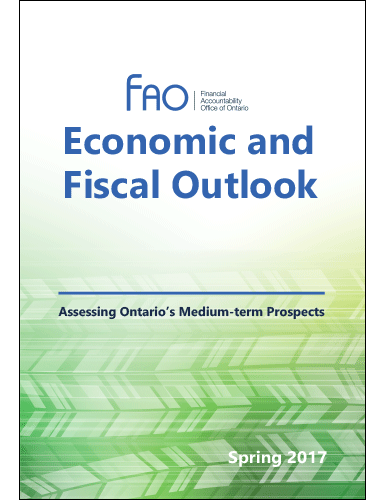1. Purpose and Scope
Ontario budgets typically provide a four-year outlook for the economy and the Province’s finances. The government also publishes regular, 25-year economic projections, but has not published a long-term fiscal forecast since 2005.[1]
This report describes a projection of Ontario’s fiscal position to 2050 that reveals substantial long-term budgetary challenges for the Province. Over the next three decades, Ontario will experience significant shifts in its population and economy, as the baby boom cohort passes from working age into retirement and eventually into the final stages of life. This report assesses the budget implications of maintaining Ontario’s current fiscal structure (including program spending and tax system) through this period of demographic transition.
A long-term assessment of the Province’s current fiscal policies involves projecting trends into the future, and adopting numerous economic and fiscal assumptions, based on detailed analysis. These projections include the growth of the population, labour force, productivity, and prices. These demographic and economic projections, coupled with current trends in fiscal policies and federal-provincial agreements, help to determine the expected rate of revenue and spending growth over the projection.
The FAO’s long-term projection adopts the Ontario government’s four-year spending plan as outlined in the 2017 budget, and assumes that beyond the budget outlook, the Province will fund public services at rates reflecting population growth, price inflation, and past rates of public service enrichment (which accounts for the changing nature of public services).
The FAO’s projection is not intended to represent an exact prediction of actual outcomes over the next three decades. Instead, the analysis is intended to assess the impact on the budget over the long term if current trends in fiscal policies continue.
Assessing the long-term budget outlook involves many multi-dimensional issues. It is not possible to adequately cover every issue in a single report. The FAO’s first report on the long-term budget outlook attempts to lay out the basic framework and approach, while identifying a range of issues that could be explored in future reports. While the document cannot explore every issue in detail, it attempts to highlight the most important issues,[2] discusses the assumptions used, and suggests areas that could be revisited in later reports.
The FAO welcomes any feedback on both the analytical framework, and the issues that readers think should be addressed more fully in future reports.
2. Summary and Key Results
Over the next 35 years, Ontario will undergo a significant demographic transition, as the population becomes older and grows more slowly than in the past. The baby boom generation, accounting for over one-quarter of Ontario’s population, will be between 55 and 75 years old by 2020 and in the process of gradually transitioning out of the labour force. This transition is expected to lead to slower growth in employment and overall income.
As the baby boomers continue to age, they will require more resources from Ontario’s health care system, increasing pressure on government spending.
If current trends in fiscal policies continue, these demographic changes will combine to lower tax revenue growth and raise spending, leading to large and rising budget deficits.

Source: Ontario Public Accounts and Budgets, Statistics Canada and FAO.
Future budget deficits would lead to higher provincial debt. The FAO projects that, under current fiscal policy trends, Ontario’s net debt-to-GDP ratio would rise to 63 per cent by 2050-51, significantly above today’s ratio of around 40 per cent.[5]
Net debt-to-GDP ratio rises to 63 per cent under current fiscal policy trends
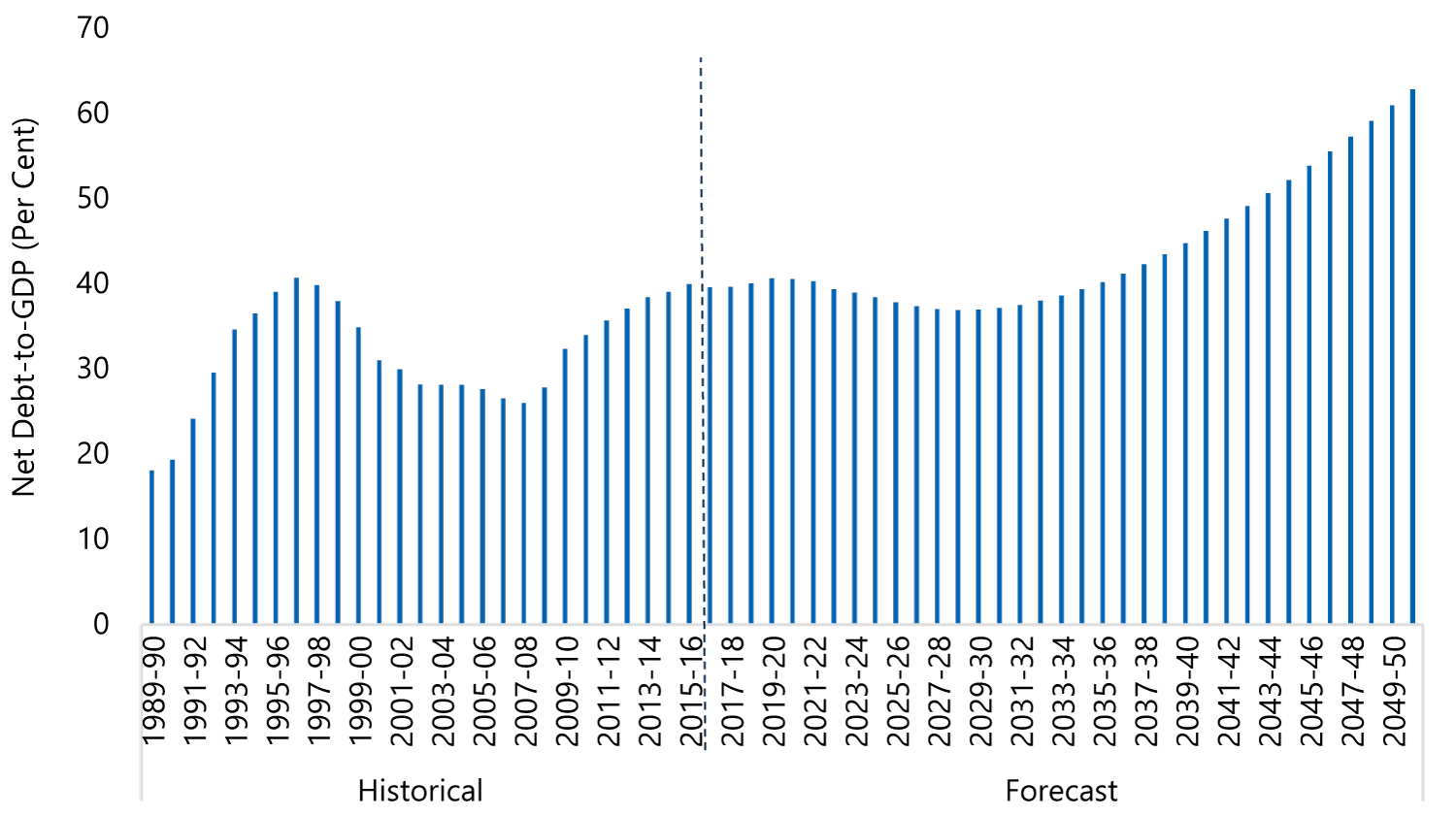
Source: Ontario Public Accounts and Budgets, Statistics Canada and FAO.
High and rising public debt can have significant consequences for Ontario. Higher debt interest payments leave the Province less fiscal flexibility, and decrease the Province's ability to use deficit spending to respond to unforeseen events, including recessions.
Ontario’s net debt-to-GDP ratio rose from about 27 per cent prior to the 2008-2009 recession to approximately 40 per cent in 2017-18. In recognition of the need to manage the Province’s debt, the Ontario government committed to lowering the Province’s net debt-to-GDP ratio back to 27 per cent by 2029-30.[6]
However, to achieve this target by 2029-30 in the face of Ontario’s coming demographic transition, the FAO estimates that the Province would need to permanently raise revenue or lower spending by at least 0.75 per cent of GDP, beginning in 2018-19. This amounts to a $6.5 billion[7] fiscal adjustment in 2018-19, and is roughly equivalent to:
- removing funding for about 40 per cent of the province’s hospitals, or
- raising the Harmonized Sales Tax rate by 2 percentage points, or
- a 25 per cent increase in federal government transfers to Ontario.
This fiscal adjustment would result in annual budget surpluses for the Province from now until 2030. An important conclusion of the FAO’s long-term projection is that simply balancing the Provincial budget will not be sufficient to achieve a net debt-to-GDP ratio of 27 per cent by 2029-30.
Convincing Ontarians of the need for immediate fiscal restraint of this magnitude would be challenging for any Ontario government. Since the demographic pressures on the budget will not intensify until the mid-2020s, it will be tempting for governments to ignore or postpone the needed adjustments to fiscal policy.
However, if the Province delays raising revenue or reducing spending, Ontario’s net debt will continue to accumulate, making it costlier to meet the Province’s future fiscal targets. Importantly, if the needed fiscal adjustments are postponed, the burden of stabilizing Ontario’s public finances would be increasingly shifted from the baby boom generation to younger Ontarians.
While there is significant uncertainty associated with Ontario’s future economic performance, policymakers should not use this uncertainty as a reason for ignoring the very real long-term budget challenges that lie ahead.
3. The Demographic and Economic Projection
3.1 Key Points
Over the projection horizon (2016 to 2050)[8]:
- Ontario’s population and labour force will grow more slowly than in the past, and Ontarians aged sixty-five and over will comprise a much larger share of the population;
- Labour productivity is expected to grow somewhat slower than its long-term historical average, but stronger than the average pace since the 2008-2009 recession;
- The Ontario economy is projected to grow more slowly than in the past, primarily due to slower labour force growth;
- In particular, nominal GDP (a key driver of government tax revenue) is expected to grow somewhat slower over the projection than it has since the early 1990s.
Summary of the FAO’s Demographic and Economic Projection
|
Average Growth |
Actual |
Projection |
||||
|---|---|---|---|---|---|---|
|
1992-2015* |
2016-20 |
2021-30 |
2031-40 |
2041-50 |
2016-50 |
|
|
Nominal GDP |
4.1 |
4.1 |
3.8 |
3.9 |
3.8 |
3.9 |
|
GDP Deflator |
1.6 |
1.9 |
1.9 |
1.9 |
1.9 |
1.9 |
|
Real GDP |
2.5 |
2.2 |
1.9 |
2.0 |
1.9 |
2.0 |
|
Labour Productivity |
1.3 |
1.1 |
1.1 |
1.1 |
1.1 |
1.1 |
|
Labour Force |
1.2 |
0.9 |
0.8 |
0.9 |
0.7 |
0.8 |
|
Employment |
1.4 |
1.1 |
0.8 |
0.9 |
0.8 |
0.9 |
|
Unemployment Rate** |
7.7 |
6.3 |
6.0 |
5.8 |
5.6 |
5.9 |
|
Population |
1.2 |
1.2 |
1.1 |
0.9 |
0.7 |
0.9 |
|
Real GDP Per Capita |
1.3 |
1.0 |
0.8 |
1.1 |
1.1 |
1.0 |
|
Consumer Price Index |
1.8 |
2.0 |
2.0 |
2.0 |
2.0 |
2.0 |
* Reflects the period since the Bank of Canada began targeting inflation.
** Unemployment Rate is per cent unemployed.
Source: Statistics Canada and FAO.
The FAO’s long-term economic projection was developed with a macroeconomic model that integrates a demographic projection, an assumption for labour productivity growth, and an outlook for key external factors into a consistent framework.[9]
The FAO’s base case projection does not attempt to predict the business cycle – that is, the normal cyclical swings that all economies experience -- but instead projects average or trend growth over the long term. The FAO’s projection is broadly consistent with long-term private sector forecasts for Ontario (see appendix 7.2).
3.2 Ontario’s Aging Population
From 1981 until recently, Ontario’s working-age population (ages 15 to 64) made up roughly 68 per cent of the population, while Ontario’s youth outnumbered its seniors. However, over the projection, Ontario’s age structure will shift significantly.
Share of working-age population shrinks as senior population grows
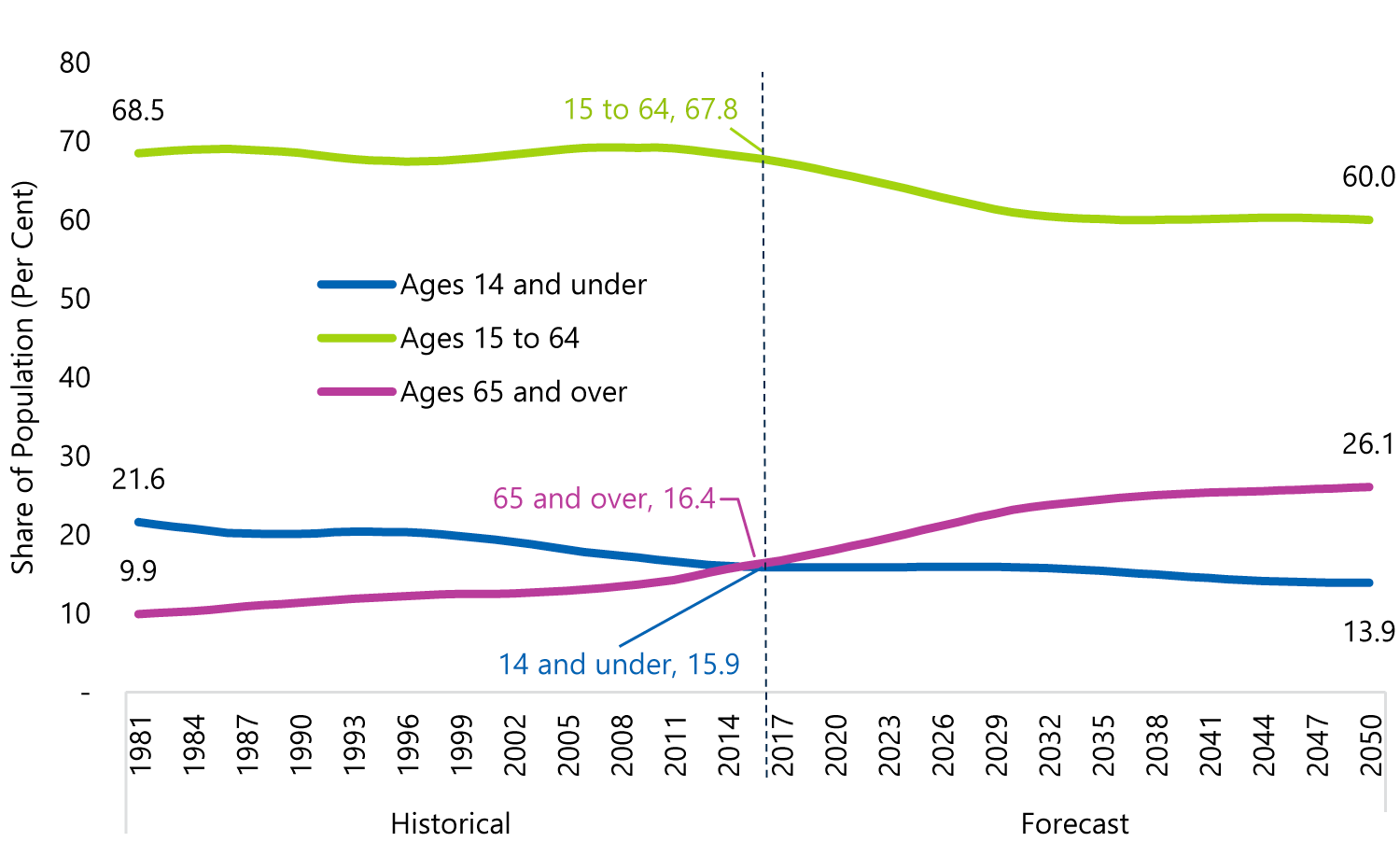
Source: Statistics Canada and FAO.
From 2016 to around 2030, the large cohort of baby boomers[10] will continue to transition from working age into their retirement years (aged 65 and over), reducing the share of Ontario’s working age population from 68 per cent in 2016 to 60 per cent by 2030.
Over the projection, the number of seniors is expected to more than double from 2.3 million in 2016 to around 5 million by 2050, increasing the share of Ontario’s seniors from around 16 per cent in 2016 to 26 per cent by 2050.
Population Growth to Slow
Ontario’s population grew at an average annual rate of 1.3 per cent per year since 1981, rising from 8.8 million to 14.0 million by 2016. The natural increase (births minus deaths) in Ontario’s population trended lower over this period, with the exception ofthe late 1980s when the baby boomers reached peak child-bearing years.
Net migration[11] expected to drive population growth
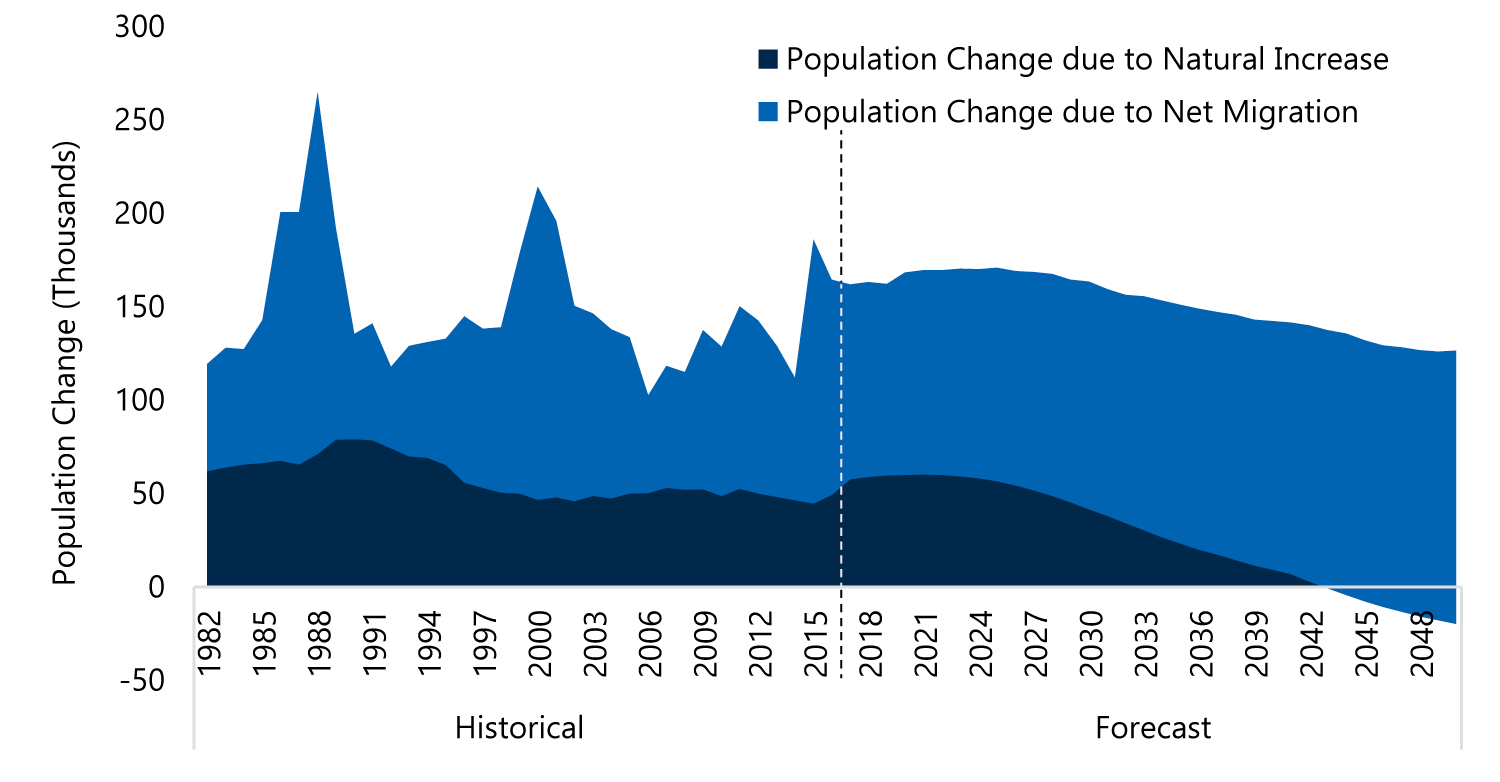
Note: There are more deaths than births in 2043 to 2050, leading to a “natural decrease” in the population in these years.
Source: Statistics Canada and FAO.
Going forward, Ontario’s population growth is expected to slow, averaging 0.9 per cent per year from 2016 to 2050. Over the next several years, natural population growth is expected to increase as the echo boomers enter peak child-bearing years. As the echo boomers move beyond their child-bearing years by the mid-2020s and older baby boomers begin to die in greater numbers, the contribution of natural increases to population growth will slowly decline. By the mid-2040s, deaths are expected to outnumber births each year, leading to natural decreases in the population.
The FAO projects that net migration will increase by 0.7 per cent per year from 2017 to 2050, eventually becoming the sole driver of population growth.[12]
Labour Force Growth Also Expected to Slow
From 1982 to 2015, the Ontario labour force[13] increased by 1.4 per cent per year on average. This period was also characterized by two significant changes in the composition of the labour force:
- a substantial increase in the number of women in the labour force (the female participation rate), and
- an increasing share of older workers (aged 55+) choosing to postpone retirement and remain in the labour force longer.
Over the projection, the FAO assumes that recent trends in the participation rates of different age groups will generally continue.
- Older workers are expected to continue to remain in the labour force in increasing numbers.
- In particular, older women are expected to contribute to this trend, as female baby boomers have higher levels of education and are more integrated into the labour force than earlier generations.
- The participation rate of core-age workers (25 to 54) is expected to remain relatively steady at current rates.
- Youth participation rates, which have been declining since the 1980s, are expected to increase slightly over the outlook[14], although rates are not expected to increase beyond the levels seen in the early 2000s.
Participation rates by age group

Source: Statistics Canada and FAO.
While the participation rate of each age cohort is expected to increase over the projection, the overall participation rate (ages 15+) is projected to decline from 65.0 per cent in 2016 to 62.6 per cent by 2030. This is largely due to the baby boom cohort retiring and leaving the labour force during the 2020s in increasing numbers. By 2031, all baby boomers will be 65 years of age or older.
Over the entire 2016 to 2050 period, labour force growth is projected to average 0.8 per cent per year, substantially slower than the 1.4 per cent growth from 1982 to 2015.
Ontario’s labour force growth expected to slow
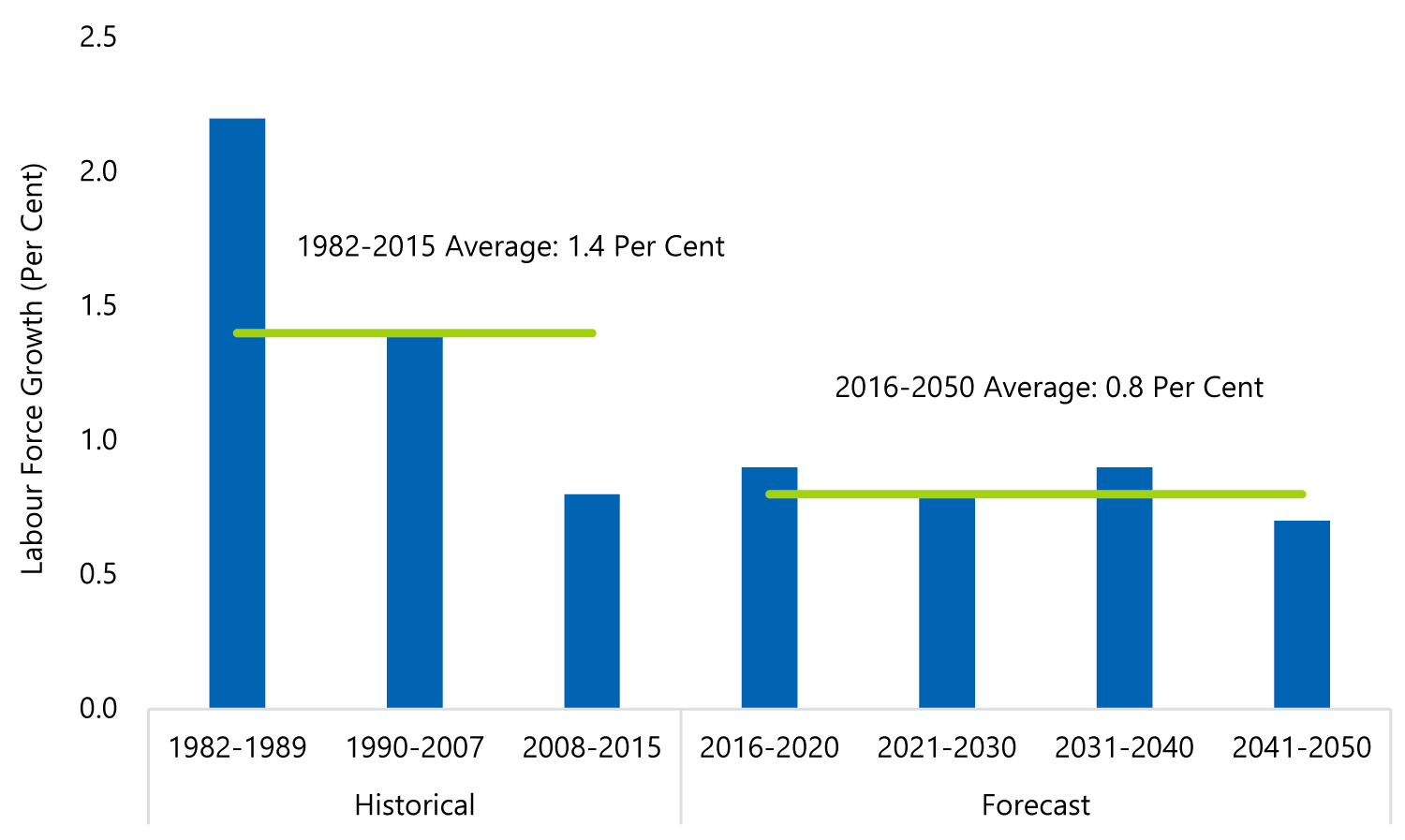
Source: Statistics Canada and FAO.
The aging of Ontario’s population leads to slower population growth and lower labour force participation, both of which result in slower labour force growth in the future. This is the primary reason that Ontario’s economic growth will be slower over the next 35 years than it was in the past.
3.3 Labour Productivity
Labour productivity – a measure of how efficiently an economy’s workers produce goods and services – is a key metric for long-term economic projections. Higher labour productivity results in higher economy-wide income for each hour worked, allowing for higher average living standards.[15]
Growth in overall labour productivity is the outcome of many inter-related factors including:
- business investments in equipment and innovation,
- public sector investments, including infrastructure and education and skills training,
- available production technologies,
- the organizational effectiveness of public and private institutions,
- the overall demand for goods and services which allows for efficiencies through ‘economies of scale’, and
- the changing industrial composition of the economy.
The linkages between productivity growth and these factors are both complex and self-reinforcing. For example, rising productivity and profits will encourage businesses to invest to expand production which will in turn increase productivity.
In the 1990s, Ontario labour productivity growth averaged just under 2 per cent per year. From 2001-2007, productivity growth slowed to an average growth rate of 0.9 per cent per year. In the post 2008-2009 recession period, labour productivity growth has averaged just 0.8 per cent. The productivity slowdown since 2000 was partly a reflection of lower demand for Ontario exports, which contributed to a broad structural shift in the composition of Ontario’s economy as high productivity manufacturing jobs were replaced by less productive service sector jobs.[16]
Labour productivity growth expected to grow above post-2000 average
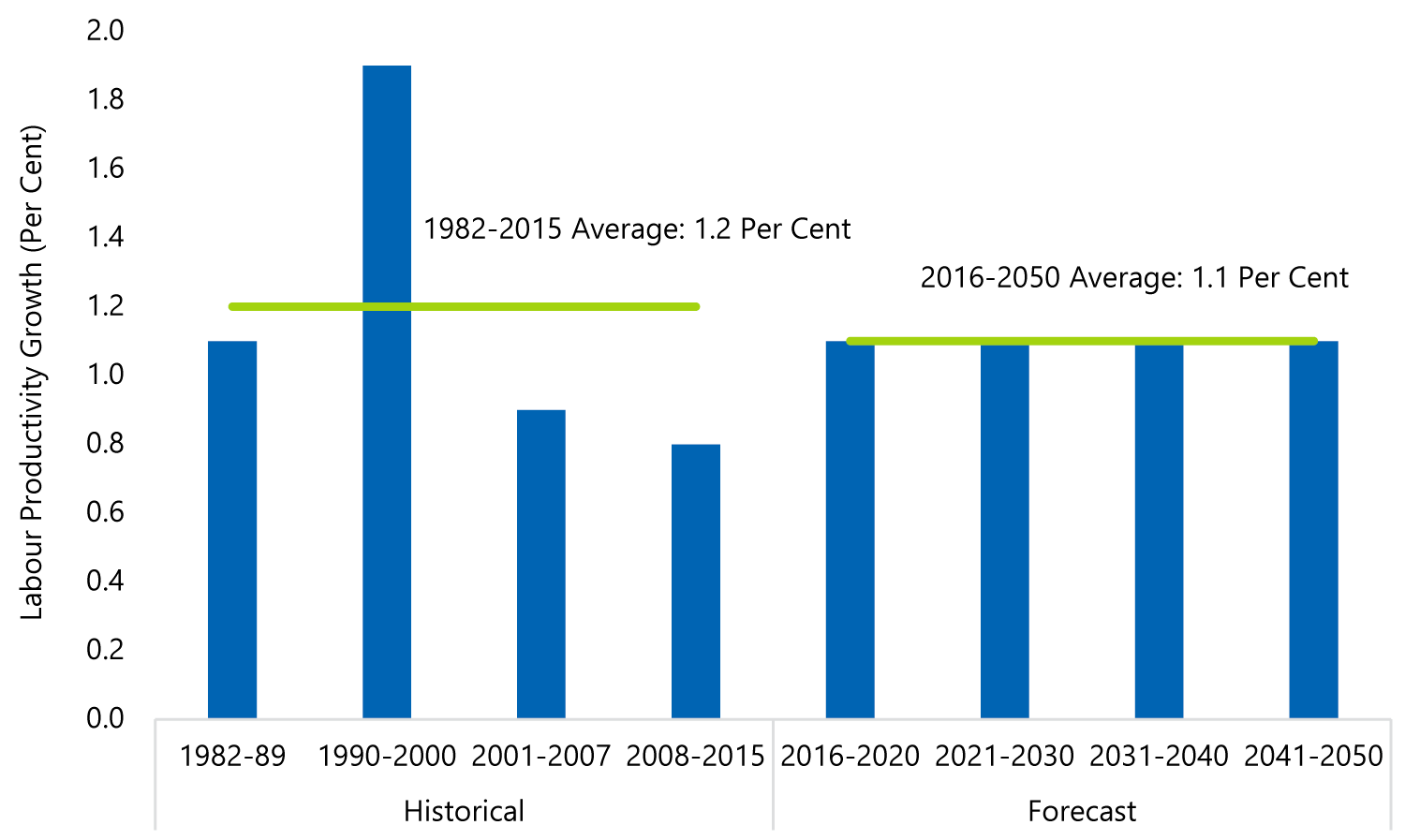
Note: Productivity is defined as real GDP per hour worked.
Source: Statistics Canada and FAO.
Combining the expectation of more moderate productivity growth (based on historical trends) with the projection of slower growth in Ontario’s labour force suggests that Ontario’s future economic growth will be slower than it has been over the past 35 years.
But the path of future technological development is uncertain. It is also possible that current and future innovations -- including artificial intelligence, quantum computing, genetics, and material sciences -- could significantly enhance the efficiency of current production processes. If so, future goods and services might be produced with fewer resources, significantly accelerating the productivity of the average worker.
Given this uncertainty, the FAO’s long-term projection is based on an assumption of productivity growth averaging 1.1 per cent per year over the next 35 years, similar to the outlook of other forecasters, but higher than the historical experience since 2000 (see Appendix 7.2).
3.4 The External Economic Environment
Ontario’s economy is influenced by a number of important external factors, including US economic growth, interest rates, the Canada-US exchange rate and energy prices.
The FAO has adopted the US Congressional Budget Office’s (CBO) long-term projection for the U.S. economy. The CBO projects average annual growth of 2.1 per cent for US real GDP over the outlook, slower than the 2.6 per cent average rate from 1992 to 2015. This reflects slower labour force growth over the CBO’s 30-year outlook, reflecting similar demographic changes in the US as are expected in Ontario.
The FAO expects interest rates to rise from current lows. The Government of Canada’s 10-year bond yield is expected to plateau at about 4.5 per cent by the 2030s, below average historical yields.[17] This reflects slower expected economic growth over the projection compared to the past 25 years, reducing the demand for capital.
Key Assumptions of the Base Case
|
Actual |
Projection |
|||||
|---|---|---|---|---|---|---|
|
Key Assumptions |
1992-2015 |
2016-20 |
2021-30 |
2031-40 |
2041-50 |
2016-50 |
|
US Real GDP Growth (Per Cent) |
2.6 |
2.1 |
2.0 |
2.1 |
2.1 |
2.1 |
|
US Unemployment Rate (Per Cent) |
6.1 |
4.7 |
4.9 |
4.9 |
4.8 |
4.8 |
|
Government of Canada 3-Month Treasury-Bill Rate (Per Cent) |
3.2 |
1.3 |
3.0 |
3.3 |
3.3 |
2.9 |
|
Government of Canada 10-year Bond Yield (Per Cent) |
4.8 |
2.4 |
4.1 |
4.5 |
4.5 |
4.1 |
|
West-Texas Intermediate Oil Price per Barrel (US $) |
49 |
54 |
88 |
129 |
176 |
120 |
|
Canada-US Exchange Rate (US Cents) |
81 |
78 |
84 |
88 |
91 |
86 |
|
Canada Real GDP Growth (Per Cent) |
2.5 |
2.2 |
1.9 |
2.0 |
1.9 |
2.0 |
Note: Assumptions for US GDP growth and unemployment rate for 2016 to 2020 reflects the Spring 2017 EFO figures.
Source: The Congressional Budget Office, Statistics Canada, The Conference Board of Canada, The Centre for Spatial Economics and the University of Toronto’s Policy and Economic Analysis Program, FAO.
The FAO’s projection incorporates a gradual, steady rise in oil prices over the long-term to about $175 US per barrel in nominal terms by 2050. In real terms, the price of oil price rises to about $90 by 2050, in 2017 dollars. This outlook reflects the fact that oil extraction will likely become more expensive in the future, placing upward pressure on real oil prices. However, global efforts at reducing carbon emissions are expected to continue dampening demand for oil, helping to moderate the overall increase in real oil prices over the projection.
The FAO projection assumes that the Canada-U.S. dollar will gradually strengthen over the long term, from 75 cents in 2016 to about 93 cents by 2050 reflecting the gradual rise in real oil prices.
3.5 Details of the Economic Projection
The FAO is projecting long-term, average annual nominal GDP growth of 3.9 per cent between 2016 and 2050, slower than the 4.1 per cent rate from 1992 to 2015.[18] This projection for nominal economic growth is based on the outlook for a number of key economic concepts.
Real economic growth is projected to be slower over the next 35 years than was the case over the past 35 years, primarily due to slower labour force growth and slightly slower productivity growth. The GDP price deflator is expected to grow faster than historical performance over the projection, similar to the outlook of other forecasters.
Deconstructing GDP Growth
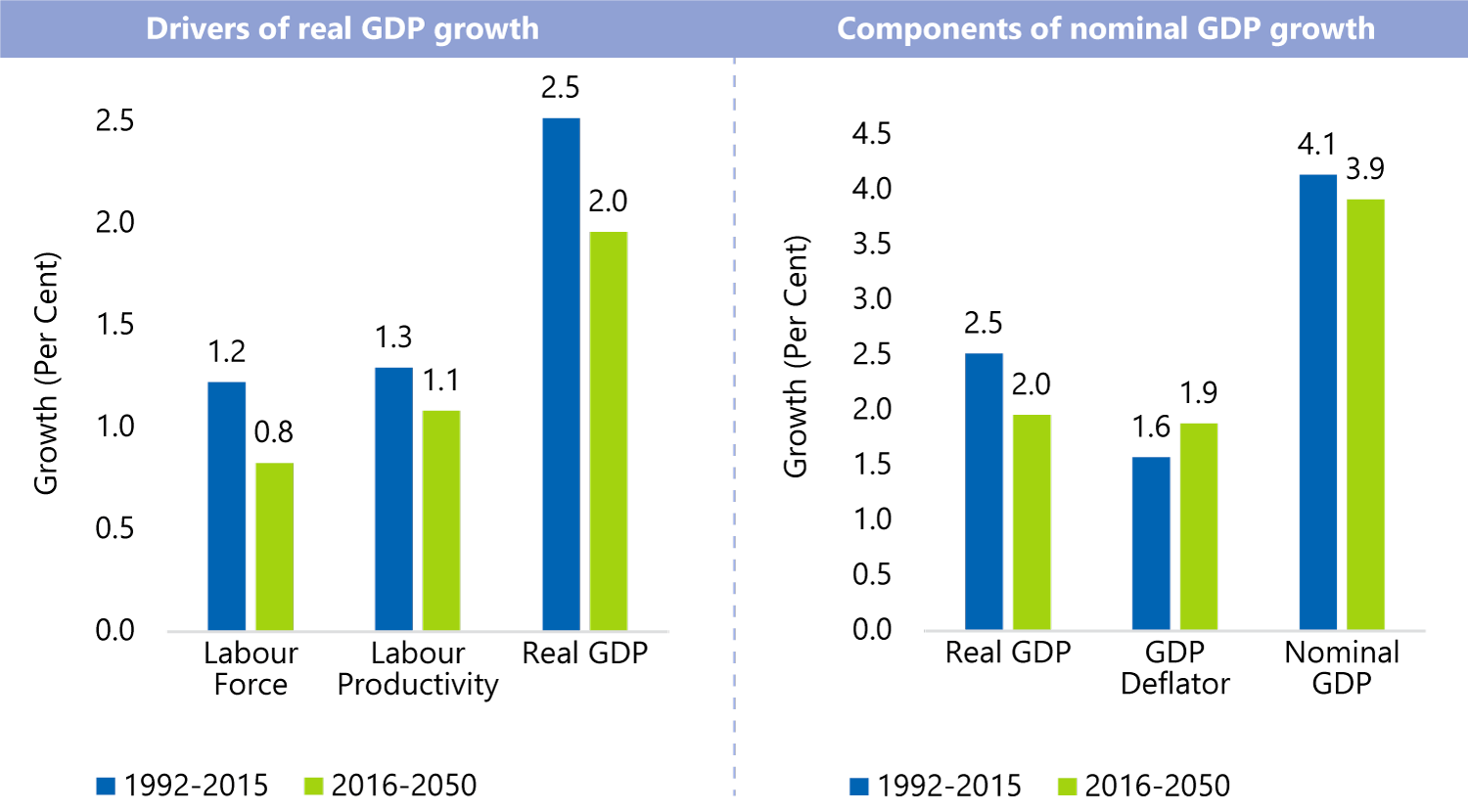
Source: Statistics Canada and FAO.
Over the projection:
- Real household consumption (that is, spending excluding the effects of price inflation) is expected to grow by 1.9 per cent per year on average, in-line with the growth in real household incomes.
- Real investment by both the private and public sectors is expected to increase by 2.0 per cent per year on average.
- Real imports and exports are expected to grow more slowly over the projection than in the past, as the pace of global trade integration slows. However, trade is expected to make a small net contribution to real GDP growth as Ontario exporters maintain their global market share.
Growth in real GDP components
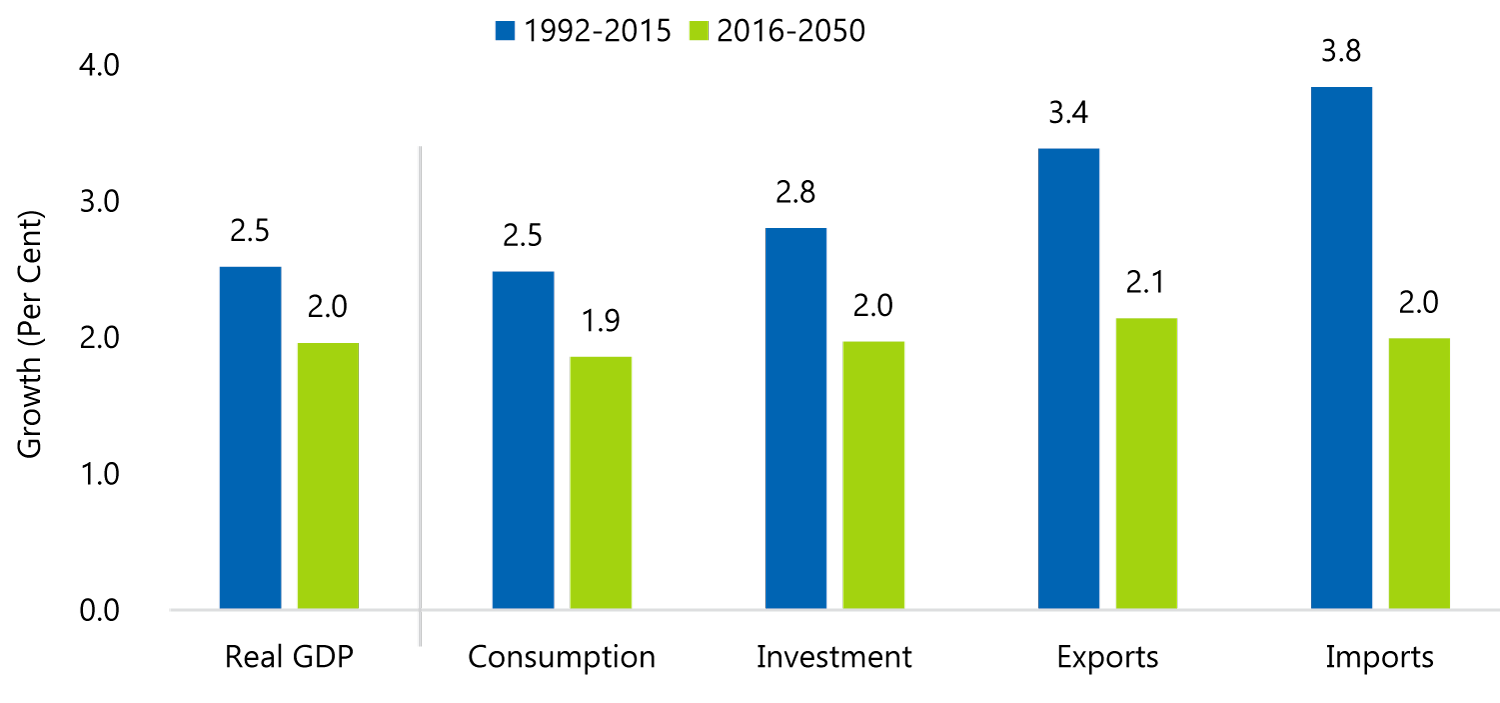
Source: Statistics Canada and FAO.
The FAO’s projection reflects a gradual decline in the unemployment rate to about 6.1 per cent by the early 2020s, down from a peak of 9.1 per cent in 2009, and below the average rate of 6.5 per cent in the early 2000s prior to the 2008-2009 recession. Over the projection, the unemployment rate trends to an average of about 5.6 per cent in the 2040s.
Unemployment rate expected to trend lower over outlook
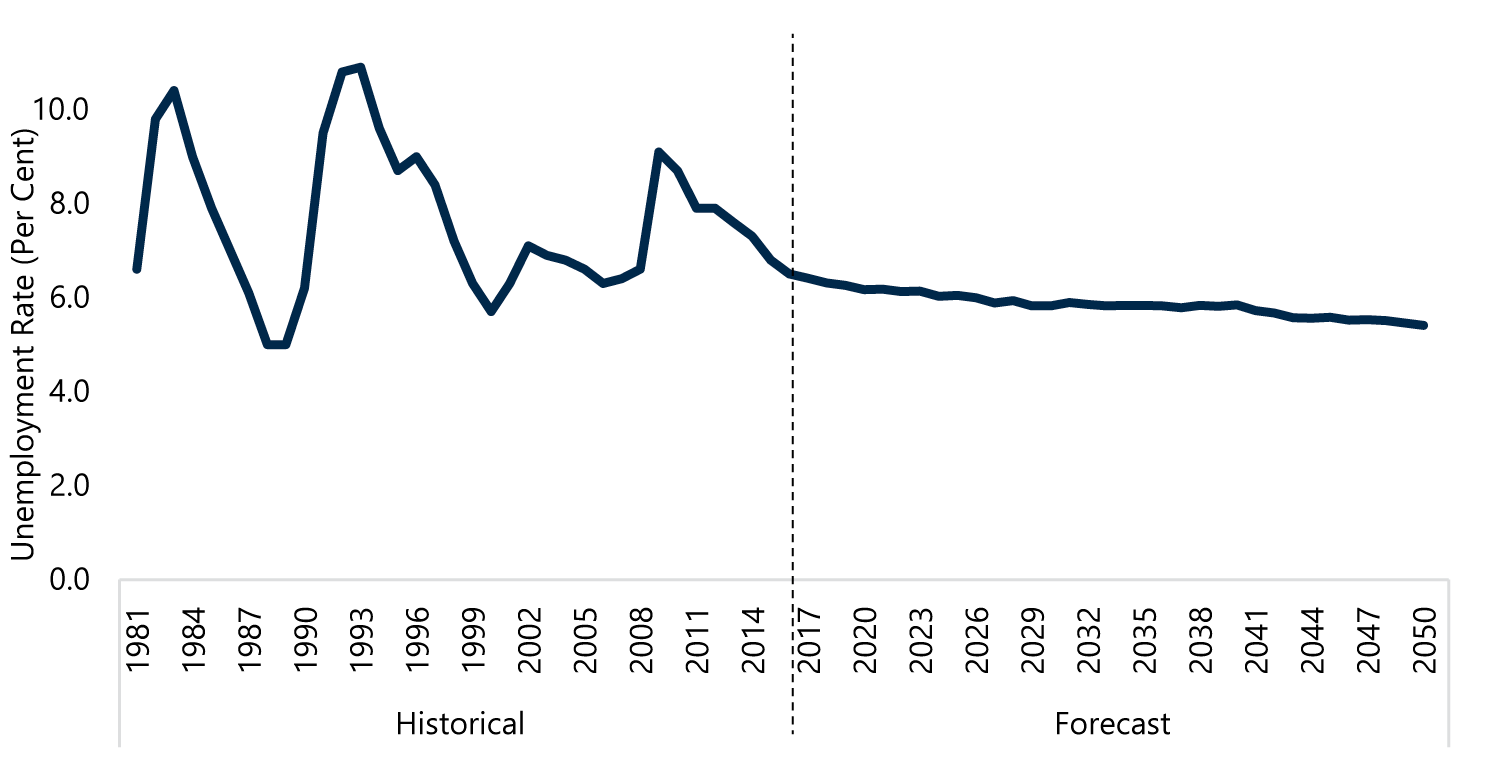
Source: Statistics Canada and FAO.
The FAO’s projection assumes the continuation of the Bank of Canada’s policy of targeting overall annual CPI inflation at 2.0 per cent.
Real per capita income is projected to grow by 1.0 per cent per year on average, somewhat slower than the average historical rate of 1.2 per cent from 1982 to 2015.
Real per capita GDP

Source: Statistics Canada and FAO.
Even so, the growth in real per capita GDP implies that on average Ontarians will be earning 40 per cent more in 2050 compared to 2016 after adjusting for inflation. This compares to a 51 per cent increase in real per capita income experienced by Ontarians over the past 35 years.
The FAO projection is also consistent with a continuation of historic trends in the shares of economy-wide income.
- The share of labour income in GDP declined from 56 per cent in 1981 to 53 per cent in 2015. The FAO projects that this share will continue to trend slightly lower to about 51 per cent by 2050.
- The share of corporate income in GDP increased from around 9 per cent in 1981 to about 14 per cent in 2015. The FAO projects that this share will continue to trend higher to about 17 per cent by 2050.
- The shares of the other components of aggregate income (net mixed income and net taxes) were fairly constant over history, which is projected to continue over the outlook.
Nominal GDP shares expected to continue historical trends over the projection
 Source: Statistics Canada and FAO.
Source: Statistics Canada and FAO.
4. The Fiscal Projection
4.1 Key Points
- In the coming decades, demographic changes in Ontario will bring significant fiscal challenges for the Province, if current trends in fiscal policies continue.
- Slower labour force growth over the projection will push economic and revenue growth below the average pace of growth experienced since 1991.
- Over the 2020s and 2030s, the baby boom cohort will enter their seventies and eighties and will require more resources from Ontario’s health care system. Higher health care spending will result in overall government spending exceeding revenues.
- Given these trends, large and rising budget deficits would emerge, resulting in higher debt and a net debt-to-GDP ratio of 63 per cent by 2050-51, well above the current ratio of about 40 per cent.
4.2 Budget Balance and Debt Outlook
Over the next 35 years, demographic changes in Ontario will contribute to significant fiscal challenges for the Province if current trends in fiscal policies remain unchanged.
Over the next two decades, slower growth in Ontario’s labour force will lead to slower economic and revenue growth than experienced over the past 35 years. Over the same period, the baby boomers will move into their seventies and eighties and require more resources from Ontario’s health care system. These factors combine to push expenses further above revenue, leading to increasingly large budget deficits, which reach 3.6 per cent of GDP by 2050-51.
Total spending rises as a share of GDP while revenue remains constant
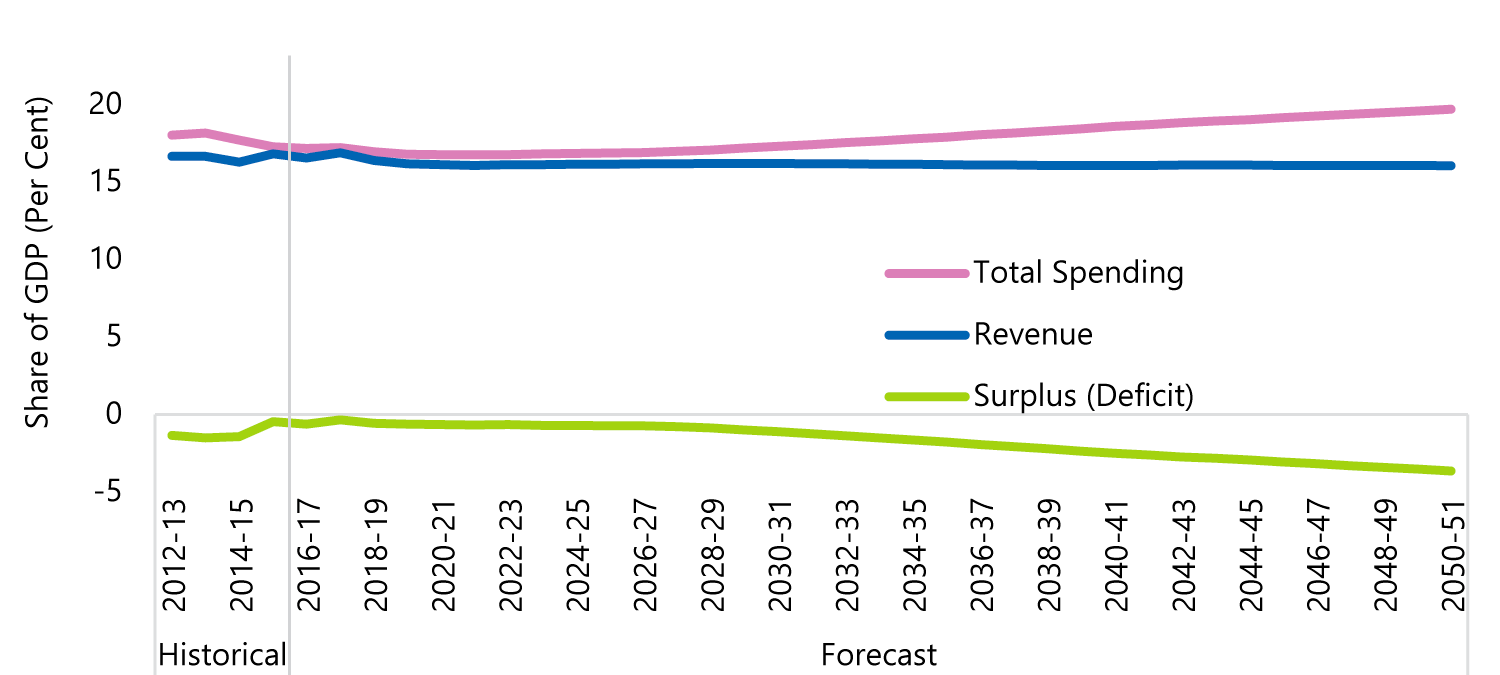
Sources: Ontario Public Accounts and Budgets, Statistics Canada and FAO.
Rising deficits will lead to significant increases in provincial debt. The FAO projects Ontario’s net debt-to-GDP ratio will rise from about 40 per cent in 2017-18[19] to 63 per cent by 2050-51.
Net debt-to-GDP ratio rises to 63 per cent under current fiscal policy trends

Sources: Ontario Public Accounts and Budgets, Statistics Canada and FAO.
Net Debt-to-GDP Ratio
Measuring government debt as a percentage of GDP is a useful way to gauge the burden of debt over time, because it expresses debt relative to the size of the economy, or the amount of income earned in a given year. The net debt-to-GDP ratio reflects economy-wide prices, real output and total incomes, factors which help determine a jurisdiction’s ability to finance its debt.
Rising debt will result in higher interest-on-debt payments, which account for an increasing share of revenues over the projection. In 2015-16, debt interest payments required 9 cents of every dollar of revenue. Based on the FAO’s projection, debt interest payments would be expected to take 22 cents of every dollar of revenue by 2050-51.[20]
Debt interest as a share of revenue expected to grow at an increasing rate over the outlook
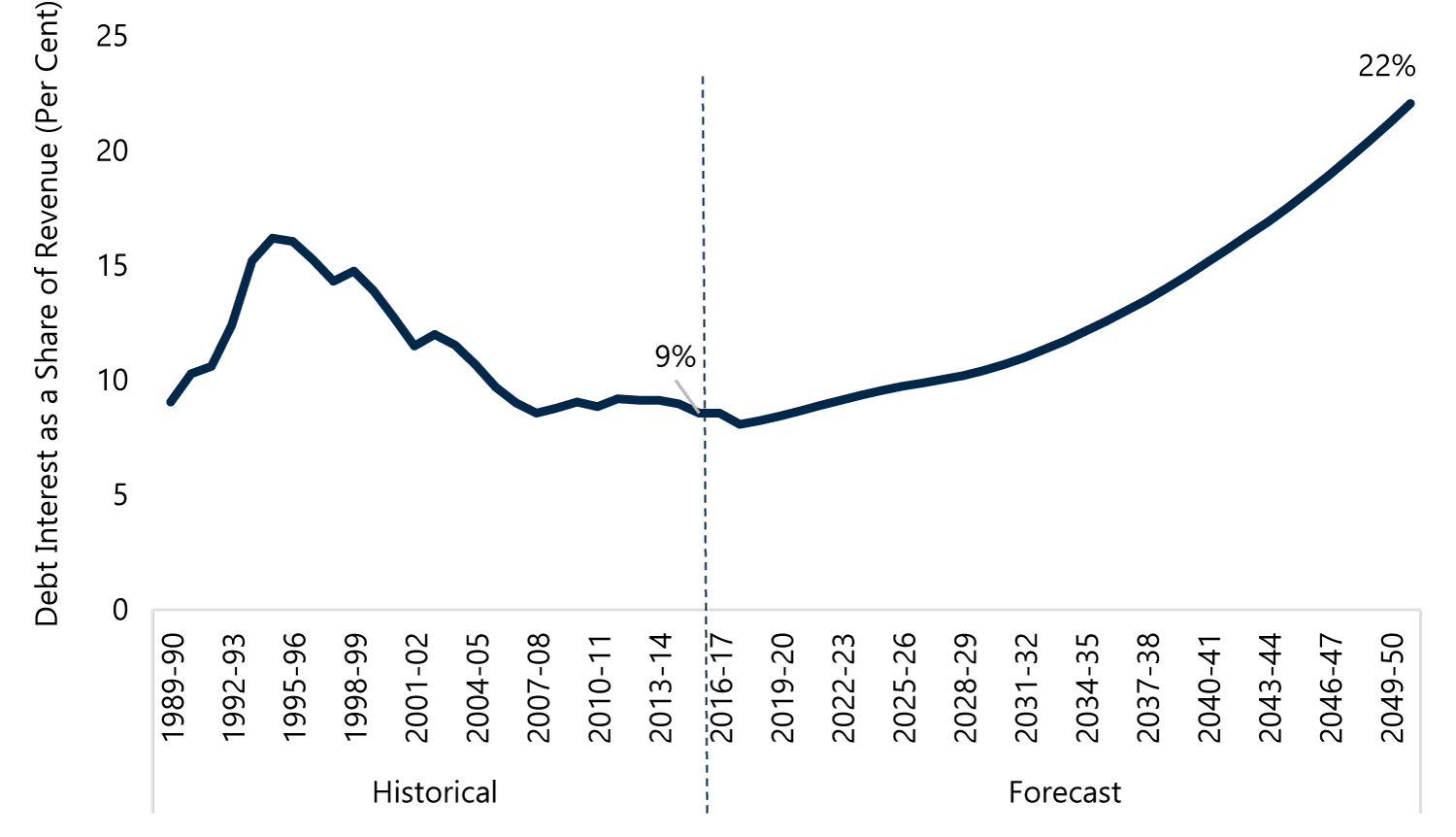
Sources: Ontario Public Accounts and Budgets, Statistics Canada and FAO.
The FAO projection assumes that rising debt interest payments will be funded by increased borrowing and not through spending cuts or tax increases. However, higher debt interest payments leave less fiscal room for spending on government priorities, such as health and education.
In 2015-16, the government spent more on debt interest than it did on postsecondary education and training. By 2050-51, the FAO projects that debt interest payments would be higher than the Province’s combined spending on primary, secondary and postsecondary education.
4.3 Revenue Projection
Provincial revenues as a share of nominal GDP have trended modestly lower over the past 25 years, declining from a high of over 18 per cent in 1991-92 to just under 17 per cent in 2015-16. This downward trend was the result of a number of factors including personal and corporate tax cuts as well as the lingering effects of the 2008-2009 global recession.
Revenues as a share of GDP assumed to remain steady over the projection
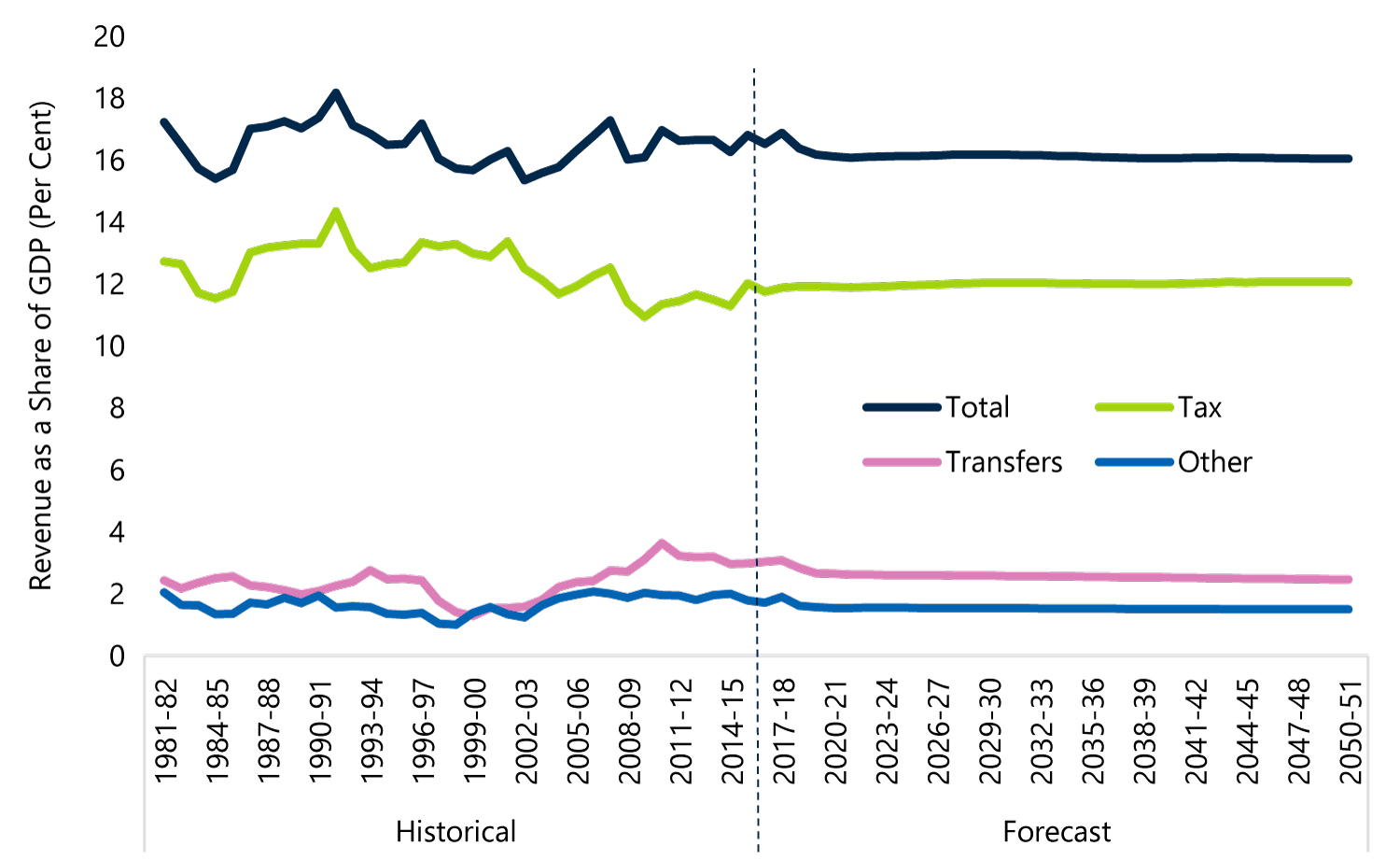
Source: Ontario Public Accounts and Budgets, Statistics Canada and FAO.
Over the next four years, the FAO projects provincial revenue as a share of GDP will continue declining to just over 16 per cent by 2020-21. This continued decline in total revenues relative to GDP reflects slower growth in federal transfers and the end of one-time revenues after 2017-18.[21] However, over the long-term, the FAO projects total provincial revenues to grow at roughly the same pace as nominal GDP.
Slower labour force growth over the projection will push economic and revenue growth below the average pace of growth experienced since 1991. Over the projection, total revenue is expected to grow 3.7 per cent per year on average, slightly below the 3.8 per cent rate from 1992-93 to 2015-16.
Revenues expected to grow slightly slower than history
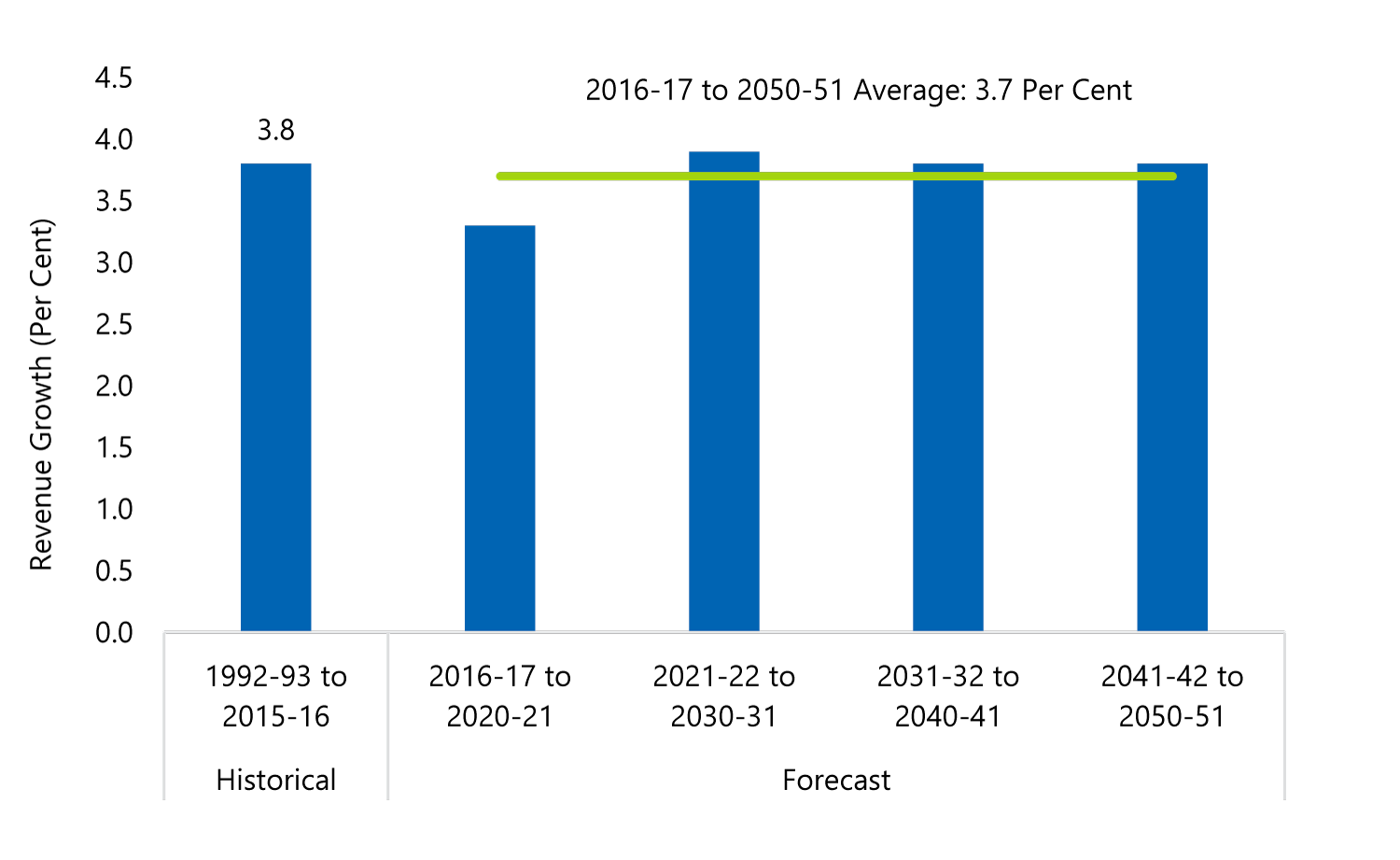
Source: Ontario Public Accounts and Budgets, Statistics Canada and FAO.
The following table outlines the main assumptions driving the FAO’s revenue projection.
|
Revenue Source |
Basic relationship |
Assumptions |
|---|---|---|
|
Personal Income Tax (PIT) |
Grows slightly faster than total compensation. |
Government will continue to index tax brackets to CPI inflation. However, real income growth will push taxpayers into higher tax brackets leading to a gradual relative increase in PIT revenues. |
|
Corporations Tax (CT) |
Grows slightly slower than corporate profits. |
Corporations will continue to use tax preferences to limit corporate tax liabilities, resulting in slower growth in corporate tax revenues relative to corporate profits. |
|
Harmonized Sales Tax (HST) |
Grows with nominal consumption. |
Continues historic trend. |
|
All other taxes |
Grow with either nominal or real GDP, depending on the nature of the tax base. |
Volume based taxes (i.e. gas tax) grow with real GDP, other taxes grow with nominal GDP. |
|
Federal Transfers |
Reflects federal-provincial agreements. |
Federal transfers based on continuation of current funding formulas. |
|
All other revenues |
Grow with nominal GDP. |
Continues historic trend. |
Tax Revenue
The FAO projects total tax revenue to grow in-line with nominal GDP over the projection.
Personal income taxes expected to rise modestly as a share of GDP
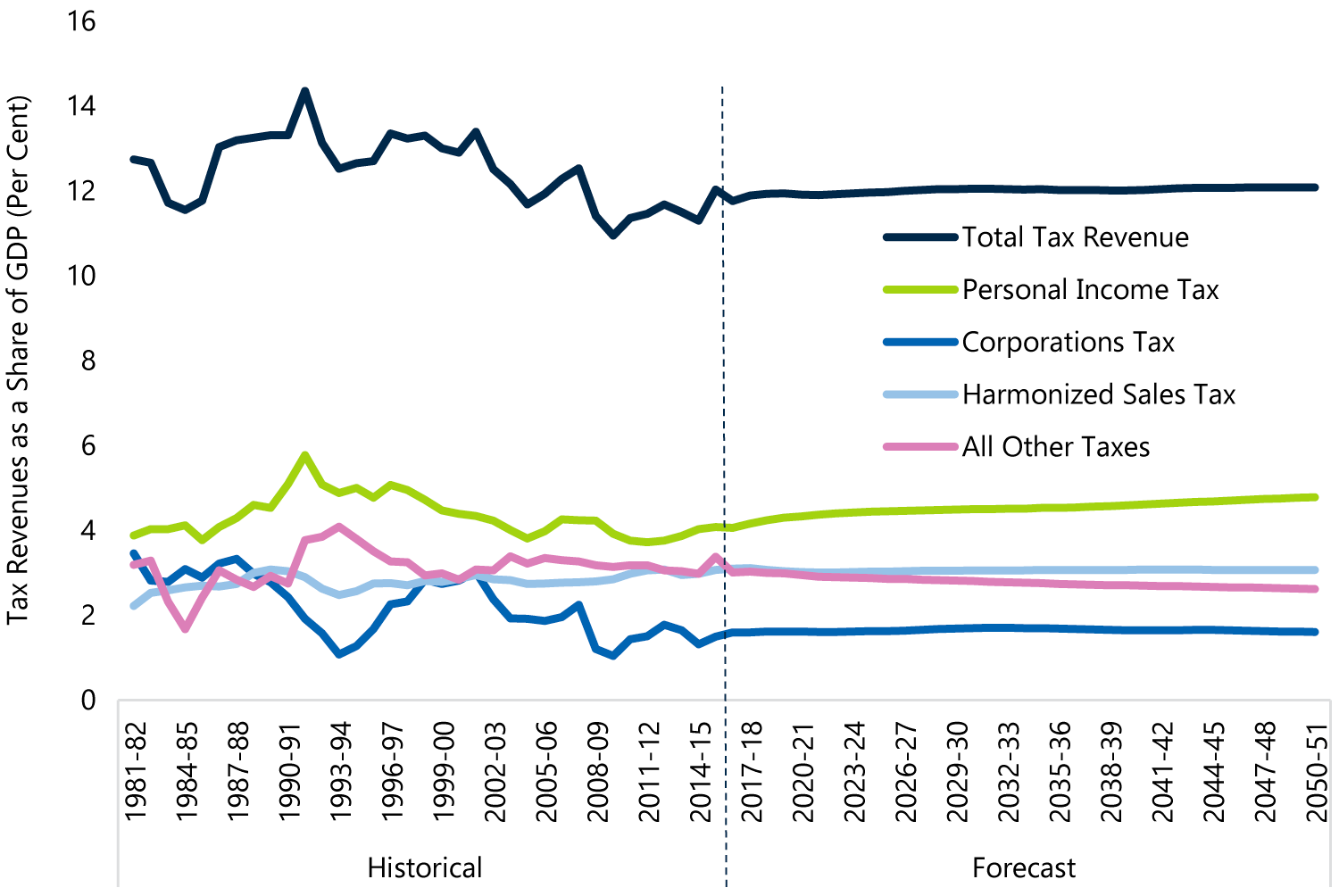
Source: Ontario Public Accounts and Budgets, Statistics Canada and FAO.
Personal income taxes are projected to comprise a gradually rising share of nominal GDP as a result of real income gains, rising from 4.1 per cent of GDP in 2015-16 to 4.8 per cent by 2050-51.
Largely due to cuts in corporate tax rates in the late 1990s and early 2000s, corporate taxes as a share of GDP declined from 3.0 per cent in 2001-02 to 1.5 per cent by 2015-16. Over the projection, corporate taxes are projected to remain fairly stable as a share of GDP, reaching 1.6 per cent by 2050-51.
The share of sales tax to nominal GDP is projected to remain constant over the projection, while all other taxes slowly decline from around 3.0 per cent in 2014-15, to 2.6 per cent by 2050-51, reflecting the slower growth in volume based taxes.
Taken together, overall tax revenue is expected to grow at roughly the same pace as nominal GDP over the projection, but the tax burden is projected to shift modestly towards personal income taxes and away from corporate and ‘other’ taxes.
Federal Transfer Revenue
Federal transfers are assumed to grow based on current federal-provincial agreements. Total federal transfers as a share of nominal GDP are projected to decline from 3.0 per cent in 2015-16 to 2.7 per cent in 2019-20, and continue trending slowly lower over the outlook, reaching 2.5 per cent by 2050-51.
Federal transfers as a share of GDP expected to decrease over projection
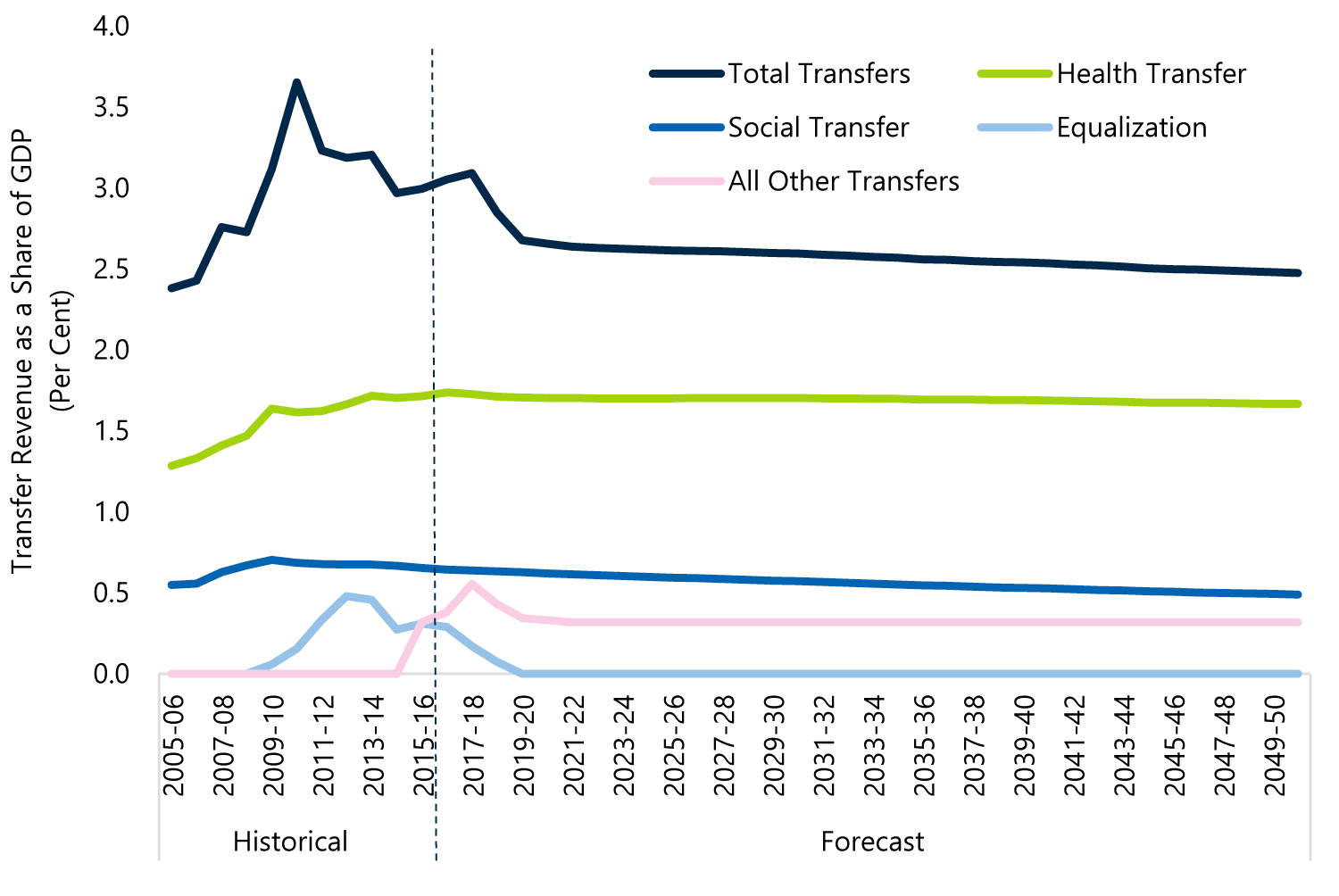
Source: Ontario Public Accounts and Budgets, Statistics Canada and FAO.
The projection for federal transfers is in contrast to the recent past (until 2010-11), when transfers grew much faster than the economy. This faster historical growth reflected federal stimulus spending (in response to the 2008-2009 recession), the federal-provincial agreement to grow the Canada Health Transfer by 6 per cent per year, and Ontario’s receipt of Equalization payments following the recession.
However, over the outlook federal transfers are expected to grow somewhat more slowly than the economy. This reflects a number of factors including:
- the federal government’s decision to continue growing the Canada Social Transfer by 3 per cent per year,
- the federal government’s decision to reduce growth in the Canada Health Transfer to the growth rate of Canadian nominal GDP starting in 2017-18,
- the FAO’s forecast that Ontario will no longer qualify for Equalization payments, as Ontario’s economy is expected to modestly outperform the rest of Canada, and
- the assumption that all other federal transfers will grow along with the economy over the projection.[22]
While the FAO assumes that current federal-provincial fiscal arrangements remain in place over the projection, future federal policy changes or federal-provincial negotiations could result in significant changes to federal transfers.
All Other Revenue
Revenues from Ontario’s government business enterprises (including the Lottery and Gaming Corporation, the Liquor Control Board and electricity enterprises) are projected to grow at the same pace as nominal GDP.
Other non-tax revenues are comprised of various fees, asset sales, royalties, and cap and trade proceeds. Other than cap and trade, these revenues are also assumed to grow with the economy.
Cap and trade revenues will ultimately be determined by how many government-issued emission permits are sold, and at what price. Assuming Ontario stays in the Western Climate Initiative’s (WCI) cap and trade program, Ontario’s emissions cap[23] must decline by roughly four per cent a year to reach Ontario’s 2050 emissions target.
The permit price in Ontario will be determined at future auctions and will reflect demand and supply pressures. However, under the WCI’s current rules, the minimum carbon price per tonne must increase by around five per cent per year. If the demand for permits exceeds supply, the price could rise much faster.
Many forecasters expect that the permit price will rise by the WCI’s minimum of five per cent per year until the mid-2020s, after which, the permit price is expected to increase at a faster rate due to the exhaustion of low cost carbon abatement opportunities.
With a five per cent increase in price and a four per cent decline in permits sold per year, the FAO assumes that cap and trade revenue will increase by one per cent per year until 2025, and then by three per cent per year over the rest of the projection, to reflect the expected tightness in the emissions permit market. However, the cost of future carbon abatement technology is highly uncertain, as are the future revenues from the cap and trade system.
Ontario’s cap and trade system is also designed to be revenue neutral, as the proceeds must be directed towards GHG reduction programs.[24]
4.4 Spending Projection
The FAO projects total Ontario government expenditures will rise from around 17 per cent of nominal GDP in 2017-18 to almost 20 per cent by 2050-51. This increase is primarily driven by rapidly rising health care expenses. However, by the 2040s higher debt interest payments also contribute to the rising GDP share of government expenditures.
Health spending rises as a share of GDP over the projection
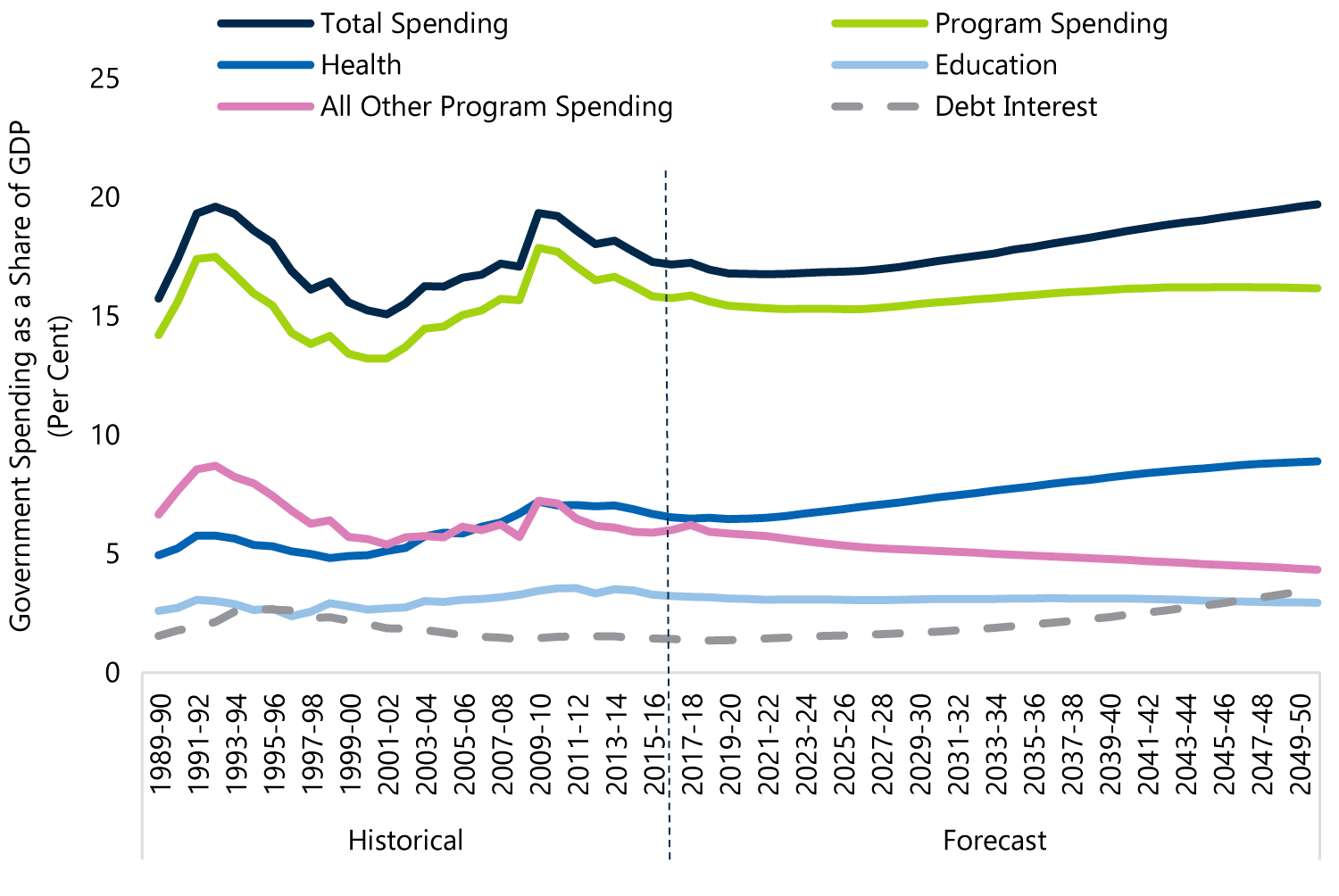
Source: Ontario Public Accounts and Budgets, Statistics Canada and FAO.
The demand for public services generally increases as the population grows and ages. In addition, as prices rise with inflation, public sector wages and the cost of providing public goods and services also increases. These underlying factors put upward pressure on program spending.
The Ontario government provides a four-year outline of spending plans in the annual budget, which the FAO incorporates into its projections. Beyond the budget projection, the FAO assumes that the government will fund public services at rates reflecting population growth, price inflation, and past rates of public service enrichment (which accounts for the evolving nature of public services).
Growth in program spending expected to accelerate until the 2040s

Notes: Other includes spending on postsecondary education and training, justice, and children’s and social services.
Sources: Ontario Public Accounts and Budgets, Statistics Canada and FAO.
In the 2000s, Ontario program spending increased by 6.5 per cent per year on average. Following the 2008-2009 recession and the sharp rise in deficits, the government restrained program spending to achieve its goal of balancing the budget by 2017-18. As a result, program spending is expected to grow at an average pace of just 2.6 per cent per year, during the 2010s.
Going forward, the FAO projects average annual program spending growth to accelerate to 4.0 per cent in the 2020s and 4.3 per cent in the 2030s, before moderating to 3.8 per cent in the 2040s.
- In the 2020s and 2030s, the aging of the baby boom cohort accelerates health care expense growth to above five per cent per year. Over the same period, the children of the echo boomers will be moving through the school system.
- In the 2040s, the majority of the baby boom generation will have died while the echo boomers’ children will have graduated from secondary school. This reduces health care and education spending pressures, lowering program spending growth to around 3.8 per cent over the decade.
Over the entire projection (2016-17 to 2050-51), program spending grows by an average of 3.9 per cent annually.
Health Care Spending
Over the long term, the FAO projection for health care spending is based on three key factors.
- Demographics: According to the Canadian Institute for Health Information, the annual per capita health care cost for an average 50-year-old is $3,000. This increases to $6,500 for a person who is 65 years old and to over $23,000 for a person who is 85 years old.[25] Ontario’s aging population will put increasing pressure on health care spending, as the large baby boom cohort begins to require significantly more health care services.
- Higher Prices for Health Care Services: Consumer price inflation is expected to average 2.0 per cent over the projection. Since health care delivery is more labour intensive than other sectors of the economy, health care prices typically rise at a faster pace than overall consumer prices.
- Health Care Enrichment: Enrichment is the change in health care spending not accounted for by population growth, aging or inflation. In addition to demographic factors, the demand for health services also increases with the introduction of new technologies, rising incomes, and the underlying health of the population, among other things.[26] The FAO assumes that governments will increase the growth of health care enrichment to meet these additional demand pressures at a pace similar to that of the past fifteen years.
From 1982-83 to 2015-16, health care costs grew by 7.2 per cent per year on average. Over the projection, the FAO estimates that health care costs will grow at an average rate of 4.8 per cent per year.
Components of the Health Spending Projection
|
(Average Growth, Per Cent) |
1982-83 to 2015-16 |
2016-17 to 2050-51 |
|---|---|---|
|
Health Inflation |
4.0* |
2.2 |
|
Population Growth |
1.3 |
0.9 |
|
Population Aging |
0.7 |
1.0 |
|
Enrichment |
1.1 |
0.7 |
|
Total ** |
7.2 |
4.8 |
* From 1992-93 to 2015-16, health inflation was 2.2 per cent and total health care spending growth averaged 4.8 per cent.
** Total historical health spending does not add to the sum of its components due to rounding.
Sources: Ontario Public Accounts and Budgets, Statistics Canada, Canadian Institute For Health Information and FAO.
Health care inflation is expected to average 2.2 per cent over the projection, slightly higher than the average pace of consumer price inflation. This rate is similar to the average historical pace of health care inflation experienced over the 1992-93 to 2015-16 period.
Slower population growth will lower the expected growth in health care costs over the projection compared to history. However, the aging of the population will place additional pressure on health care costs going forward.
From 1982-83 to 2015-16, the average rate of health care enrichment growth was about 1.1 per cent per year. However, this period includes large variations in health care enrichment growth, from a low of -4.4 per cent in 1992-93, to a high of +7.4 per cent in 2003-04.
There is a significant degree of uncertainty over the growth of health care enrichment in the future. Given this uncertainty, the FAO chose an enrichment rate that reflects Ontario’s historical experience. The FAO adopts the health care spending projections included in the 2017 budget (a period of relative spending restraint), after which the FAO assumes that health care enrichment growth will slowly rise to 0.9 per cent by 2023-24, slightly below the long-term historical average.[27] Over the entire projection period, health care enrichment is expected to add an average of 0.7 percentage points per year to overall health care spending growth.
Contribution to growth in health care spending

Sources: Ontario Public Accounts and Budgets, Statistics Canada, Canadian Institute For Health Information and FAO.
From 2012-13 to 2015-16, the government restrained the growth rate of health sector expense, largely by slowing spending growth of hospitals and the Ontario Health Insurance Plan.[28] From 2015-16 to 2019-20, the government plans to grow health sector expense at an average annual rate of 3.3 per cent, slightly below the growth of health care spending pressures.[29] Beyond 2019-20, the FAO’s long-term projection is based on the assumption that the government will fully fund the underlying cost and demand pressures in the health sector.
During the 2020s and 2030s, the aging of the baby boomer cohort will place upward pressure on health care costs, which are projected to grow by around 5.2 per cent annually over these two decades. By the 2040s, a smaller baby boom cohort will ease pressure on health care costs.
Population aging expected to accelerate health spending until 2040s

Source: FAO Calculations based on CIHI and Statistics Canada data.
Over the entire projection, health care spending is expected to outpace the growth in all other program spending. As a result, health care expenditures will comprise 55 per cent of total program spending by 2050-51, up from about 42 per cent in 2015-16.
Health as a share of total program spending expected to rise over outlook
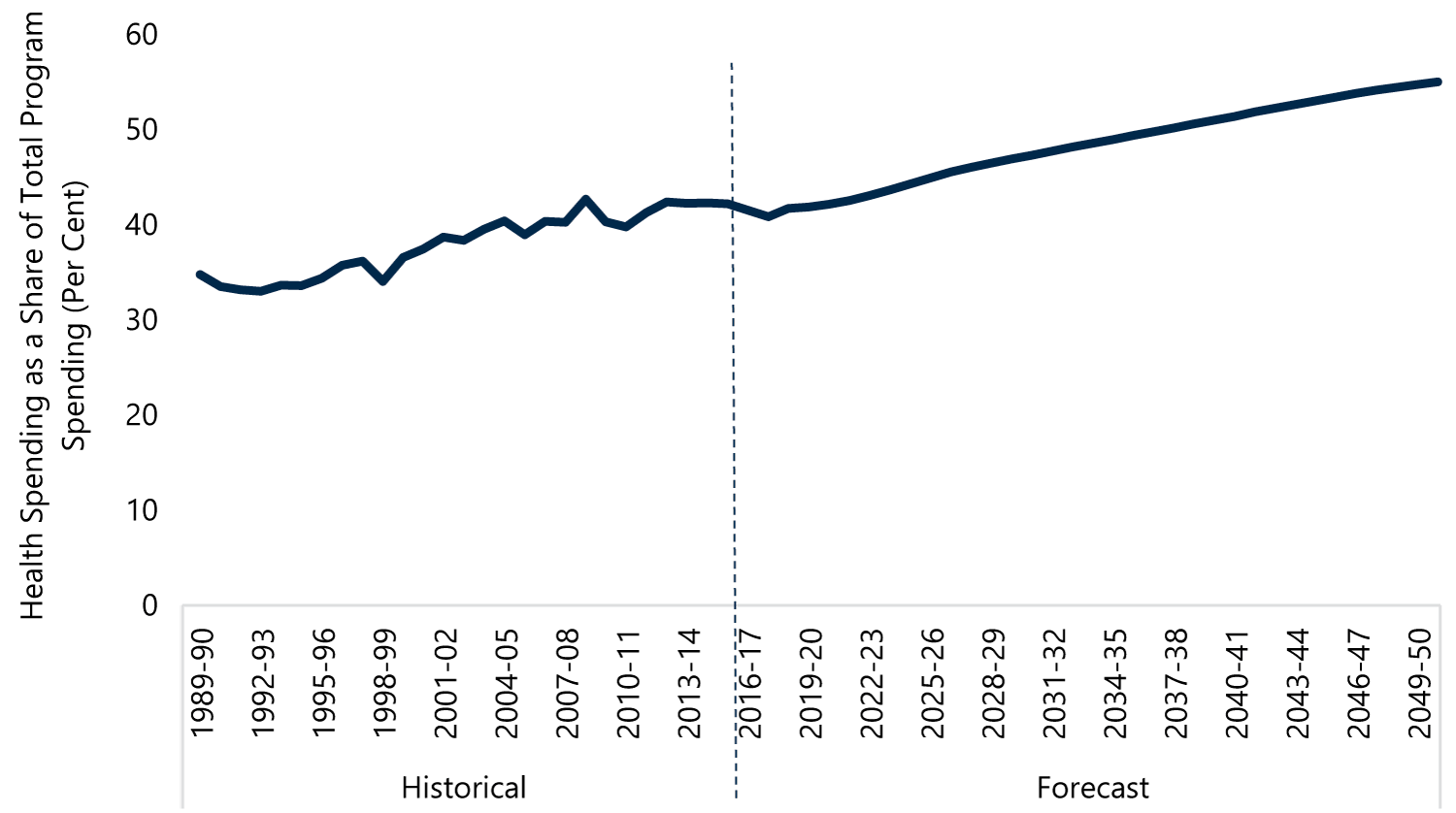 Sources: Ontario Public Accounts and Budgets, Statistics Canada and FAO.
Sources: Ontario Public Accounts and Budgets, Statistics Canada and FAO.
Education Spending
Education expenditures include spending for primary and secondary education, and child care. The FAO projects K-12 education spending based on school-age population, price inflation and an enrichment rate.
From 1992-93 to 2015-16, K-12 education spending growth averaged 4.2 per cent annually. Based on the government’s spending plans in the 2017 Budget, the FAO estimates that K-12 education enrichment will fall to 1.3 per cent by 2019-20. Going forward, the FAO assumes that enrichment growth will trend lower, averaging 1.0 per cent over the entire projection. Lower school-age population growth, price inflation and education enrichment rates leads to slower education spending over the projection than was experienced in the past.
Components of K-12 Education Spending Projection
|
(Average Growth, Per Cent) |
1992-93 to 2015-16* |
2016-17 to 2050-51 |
|---|---|---|
|
School-Age Population Growth |
0.7 |
0.6 |
|
Inflation |
1.8 |
2.0 |
|
Enrichment |
1.7 |
1.0 |
|
Total |
4.2 |
3.6 |
* Education expense data is not available prior to 1989. May not add due to rounding.
Sources: Ontario Public Accounts and Budgets, Statistics Canada and FAO.
Since 2006, school-age population has been declining in Ontario, which has resulted in lower primary and secondary school enrolment. This was due to the large cohort of echo boomers gradually leaving the education system.
Ontario’s school-age population expected to increase steadily before leveling off
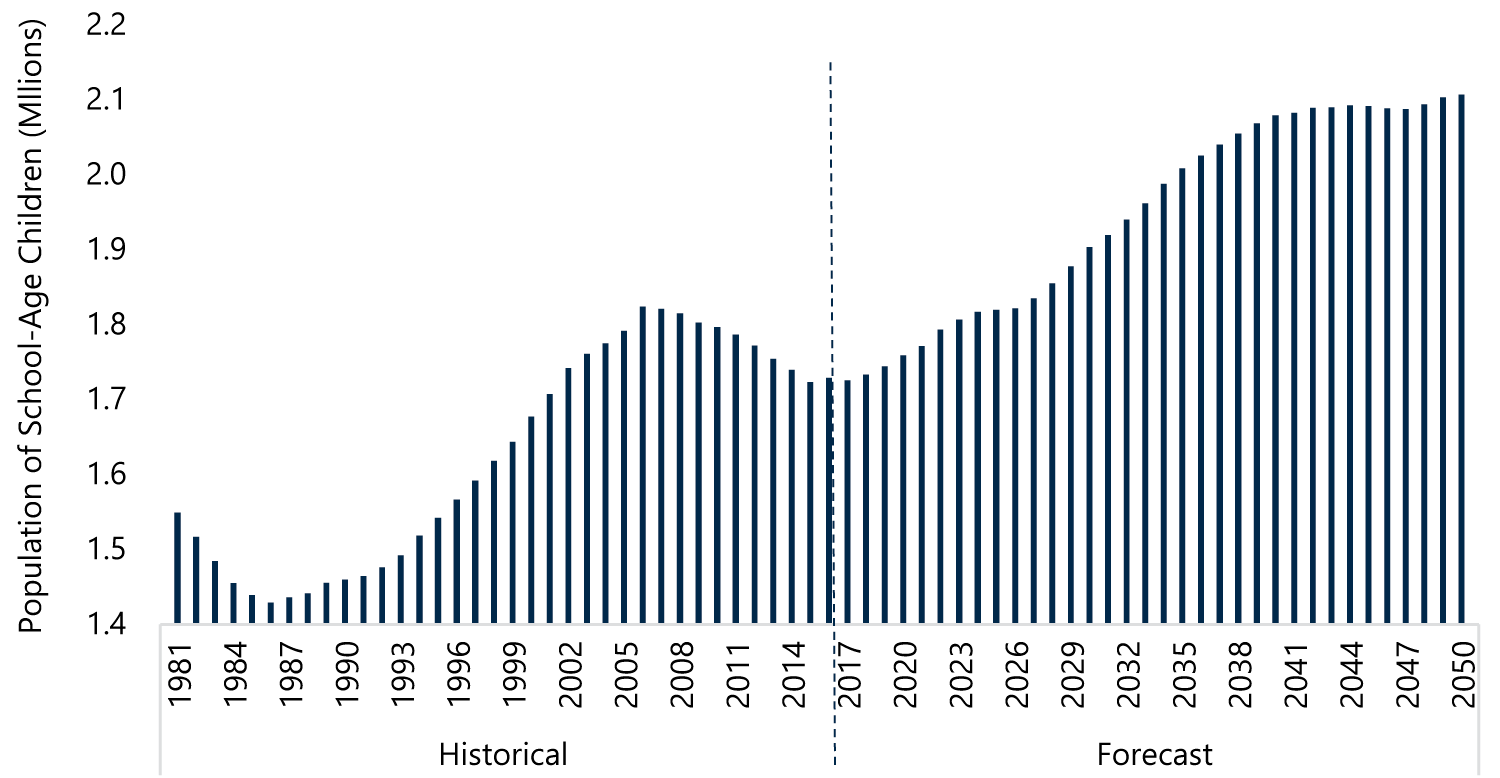 Sources: Statistics Canada and FAO.
Sources: Statistics Canada and FAO.
However, beginning in 2017, the school-age population is expected to begin increasing again, placing upward pressure on education spending. From the mid-2020s until the late 2030s, education spending growth is projected to accelerate as the echo boomers’ children begin entering kindergarten and move through the school system. After 2036, growth in the school-age population slows as this cohort begins to graduate from high school, reducing the pressure on education spending in the 2040s.
K-12 Education spending growth expected to average 3.6 per cent over outlook
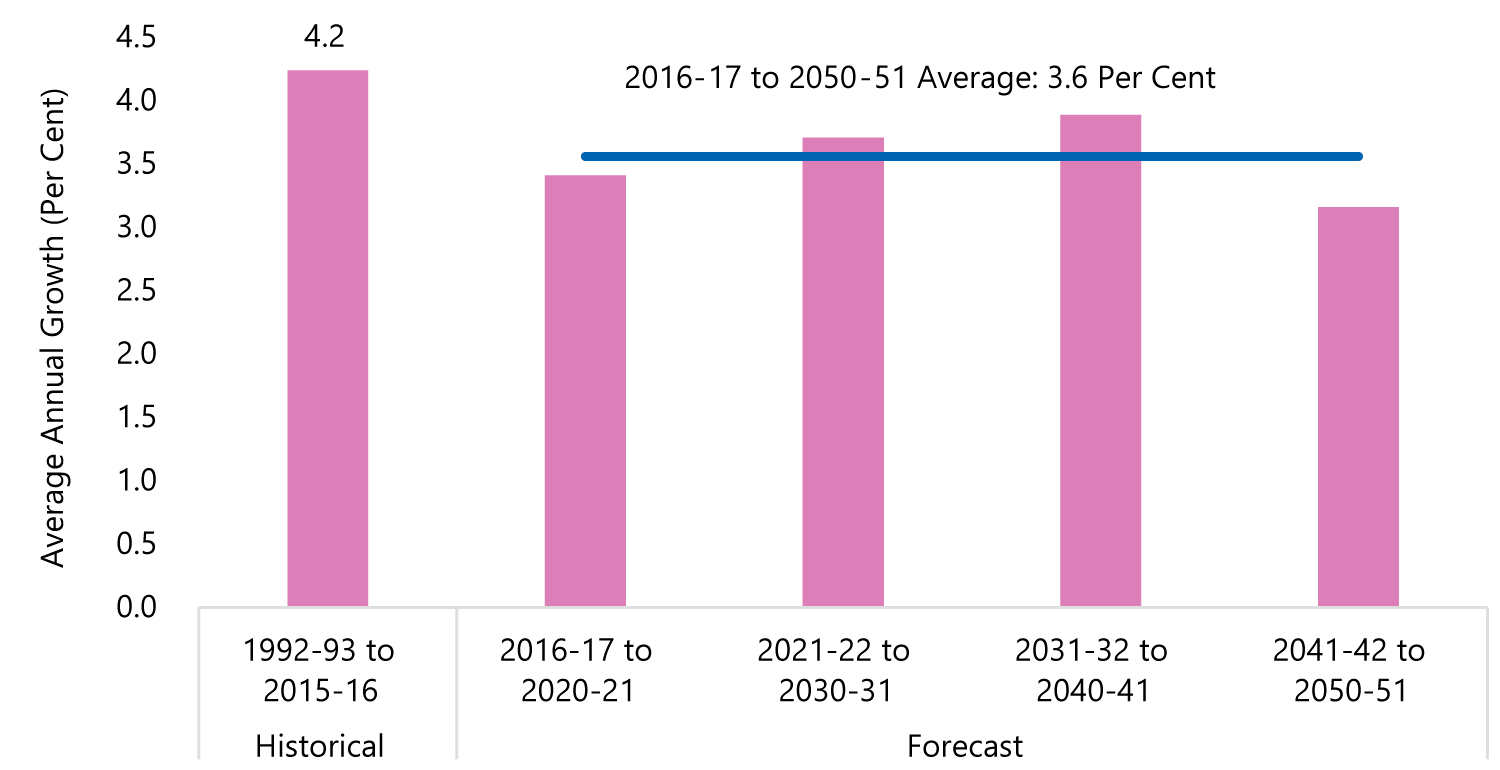
Note: Figures are K-12 education spending, which represent about 95 per cent of the total Ministry of Education budget.
Sources: Ontario Public Accounts and Budgets, Statistics Canada and FAO.
All Other Program Spending
All other program spending includes post-secondary education, justice, children and youth services, and a number of other program areas. Over the projection, spending in these categories is expected to be higher than historical trends.
All other program spending growth to be higher than historical pace

Sources: Ontario Public Accounts and Budgets, Statistics Canada and FAO.
Other program spending growth fluctuates around 3.0 per cent, due to demographic shifts which will impact post-secondary education enrolment, as well as other program areas such as justice spending.
In the near term, the government begins spending the proceeds of the cap and trade system, pushing up other program spending growth.[30] In the 2020s, the echo boomer cohort will have graduated from post-secondary education, contributing to the slower growth of other program spending. In the 2030s, the children of the echo boom begin post-secondary education, again leading to a moderate increase in other program spending growth.
Infrastructure Spending
The FAO projects capital spending for each major program sector (such as health, education and transportation) based on underlying cost drivers including demographics, price inflation and economic growth.[31]
Based on the government’s 2017 Budget forecast, real infrastructure spending per capita is expected to peak in 2019-20 before trending lower through the mid-2020s. Over the longer-term, the FAO projects real per capita infrastructure spending to return to pre-recession levels.
Real Ontario Capital Spending Per Capita (2017 Dollars)
.gif)
Sources: FAO and Ontario Ministry of Infrastructure.
The FAO estimates that infrastructure spending will contribute more than one-third of net new borrowing over the projection.
5. Achieving Ontario’s Fiscal Targets
5.1 Key Points
- The government has committed to lowering Ontario’s net debt-to-GDP ratio to 27 per cent, currently projected to be achieved by 2029–30. To achieve this, the FAO estimates that the Province would need to permanently raise revenue or lower spending by at least 0.75 per cent of GDP beginning in 2018-19 (equivalent to $6.5 billion in that year).
- This adjustment would result in budget surpluses over the next 15 years, allowing the Province to reduce net debt and create the fiscal room necessary to accommodate the fiscal impacts of the coming demographic transition.
- This adjustment would represent a significant challenge in the short term, equivalent to removing funding for about 40 per cent of the province’s hospitals, or raising the Harmonized Sales Tax rate by two percentage points, or increasing federal government transfers to Ontario by about 25 per cent.
- A potential alternative fiscal target might be to ensure that Ontario’s net debt-to-GDP ratio never exceeds its current value of about 40 per cent. In this case, the FAO estimates that the government would still need to make a permanent fiscal adjustment of 0.5 per cent of GDP beginning in 2018-19 (equivalent to $4.1 billion in that year).
- However, this alternative target would not be sufficient to fully stabilize the Province’s finances, as Ontario would continue to experience increasing budget deficits and a rising net debt-to-GDP ratio over the last 17 years of the projection.
- Since Ontario’s demographic pressures will not intensify until the mid-2020s and 2030s, it could be tempting for governments to postpone any adjustments to fiscal policy. However, delaying action would significantly increase the fiscal adjustment required to achieve the same fiscal target.
- Importantly, postponing the fiscal adjustment would increasingly shift the burden of adjustment from the baby boom generation onto younger Ontarians.
5.2 Adjusting Ontario’s Fiscal Policy
High and rising public debt could have significant consequences for Ontario. Higher debt interest payments leave the Province less fiscal flexibility, and decrease the Province's ability to use deficit spending to respond to unforeseen events, including recessions.
In addition, higher debt burdens typically result in higher interest rate premiums. But, at some point, high levels of debt relative to the size of the economy could lead investors to lose confidence in the Province’s ability to service its debt obligations, leading to sharply higher interest rate premiums.
Ontario’s net debt-to-GDP ratio rose from about 27 per cent prior to the 2008-2009 recession to around 40 per cent in 2017-18.[32] Recognizing the consequences associated with high debt burdens, the Ontario government has committed to “… a target of reducing the net debt-to-GDP ratio to its pre-recession level of 27 per cent, currently projected to be achieved by 2029–30.”[33]
FAO projects net debt-to-GDP ratio of 37.5 per cent by 2029-30
 Source: Ontario Public Accounts and Budgets, Statistics Canada and FAO.
Source: Ontario Public Accounts and Budgets, Statistics Canada and FAO.
The government’s projection of a steady decline in the net debt-to-GDP ratio is based on a number of assumptions:
- Average annual nominal GDP growth of 4.0 per cent,
- On-going balanced budgets each year, and
- The government’s infrastructure spending plan as set out in the 2017 Ontario Budget.
In contrast, the FAO’s long-term projection for the net debt-to-GDP ratio is based on:
- Average annual nominal GDP growth of 3.9 per cent from 2018 to 2029,
- A gradual deterioration in the Province's deficit under current fiscal policies, and
- An FAO projection of future infrastructure spending, consistent with the government’s 13-year, $190 billion infrastructure plan.
The primary difference between these projections is the different outlook for Ontario’s budget balance – the FAO projects on-going and deteriorating deficits under current fiscal policies, while the government is assuming an uninterrupted succession of balanced budgets to 2029-30.
The coming demographic transition will put significant pressure on Ontario’s budget, and unless the government takes action to raise revenue or lower expense, the FAO’s projection suggests that the budget will not remain balanced from 2018-19 to 2029-30. By 2029-30, the FAO projects Ontario’s net debt-to-GDP ratio will be 37 per cent, 10 percentage points higher than the government’s 27 per cent target.
Achieving 27 per cent by 2029-30
Beginning with the FAO’s base case projection, the FAO estimated the required fiscal policy adjustment (that is, the required revenue increase or spending reduction) that would lower the Province’s net debt-to-GDP ratio to 27 per cent by 2029-30.
Based on the FAO’s analysis, the government would need to permanently increase revenue and/or reduce spending by at least 0.75 per cent of GDP beginning in 2018-19 to achieve a net debt-to-GDP ratio of 27 per cent by 2029-30. In 2018-19, this would amount to a $6.5 billion fiscal adjustment, increasing with GDP over the projection.[34]
Raising revenue or lowering spending by $6.5 billion in 2018-19 is equivalent to:
- removing funding for about 40 per cent of the province’s hospitals, or
- raising the Harmonized Sales Tax rate by 2 percentage points, or
- increasing federal transfers to Ontario by 25 per cent.
A permanent fiscal adjustment (higher revenue or lower spending) equivalent to 0.75 per cent of GDP would lead to budget surpluses until 2033-34. This would reduce Ontario’s net debt and create the fiscal room necessary to accommodate the slower revenue growth and increased health care spending expected in the future.
Achieving 27 per cent requires budget surpluses to 2033-34
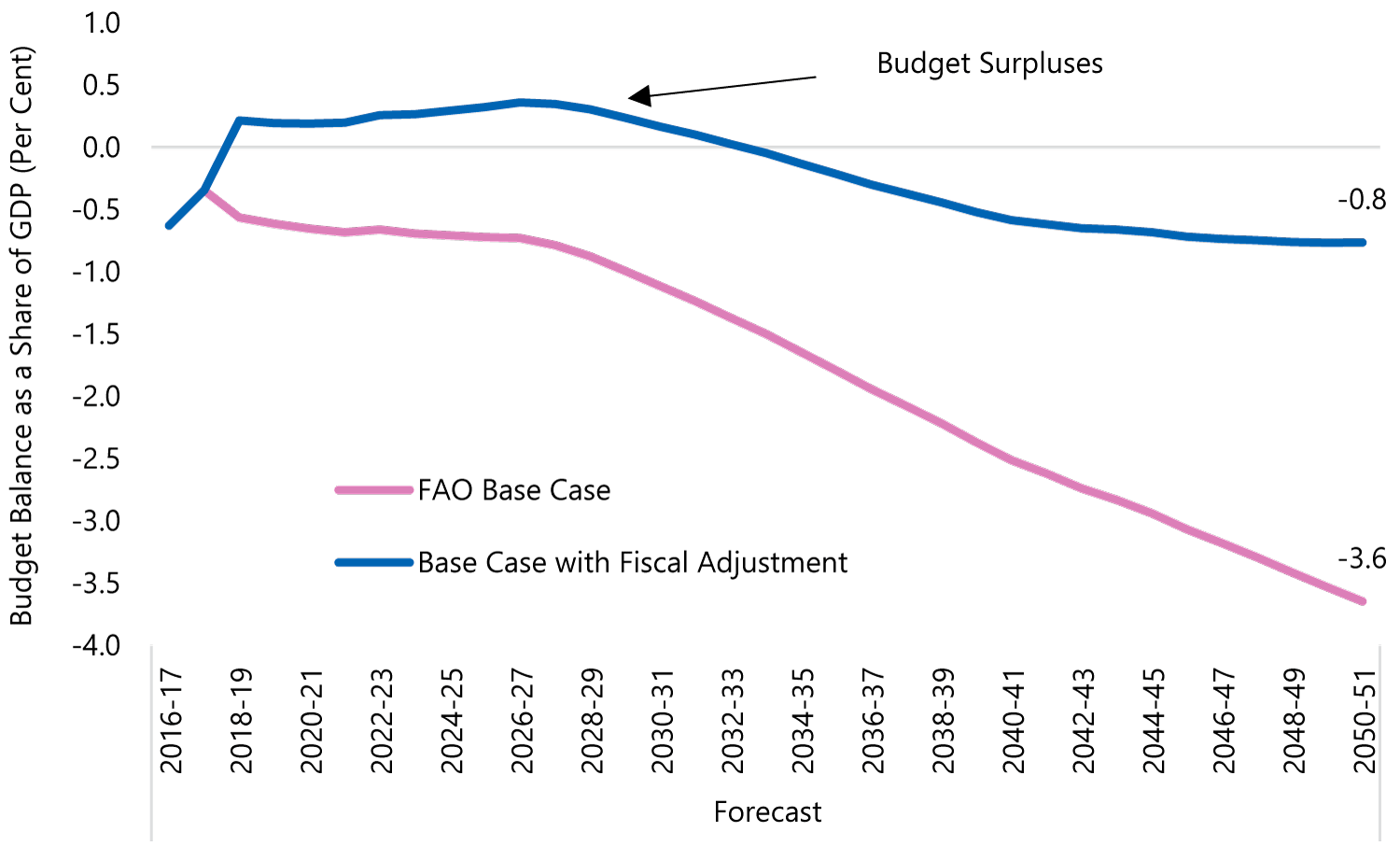 Source: Ontario Public Accounts, Statistics Canada and FAO.
Source: Ontario Public Accounts, Statistics Canada and FAO.
Even with this fiscal adjustment, modest deficits are still projected to re-emerge in the 2030s as expense growth outpaces revenue growth from the continued pressure on the health care budget. In the 2040s, program spending growth re-aligns with revenue growth, and as a result, deficits in the 2040s remain modest.
With the fiscal adjustment incorporated into the projection, the FAO estimates that the Province’s net debt-to-GDP ratio would gradually decline to the government’s 27 per cent target by 2029-30, and continue declining to a low of around 24 per cent in the mid-2030s.
Fiscal adjustment of 0.75 per cent of GDP achieves Ontario’s net debt-to-GDP target of 27 per cent by 2029-30
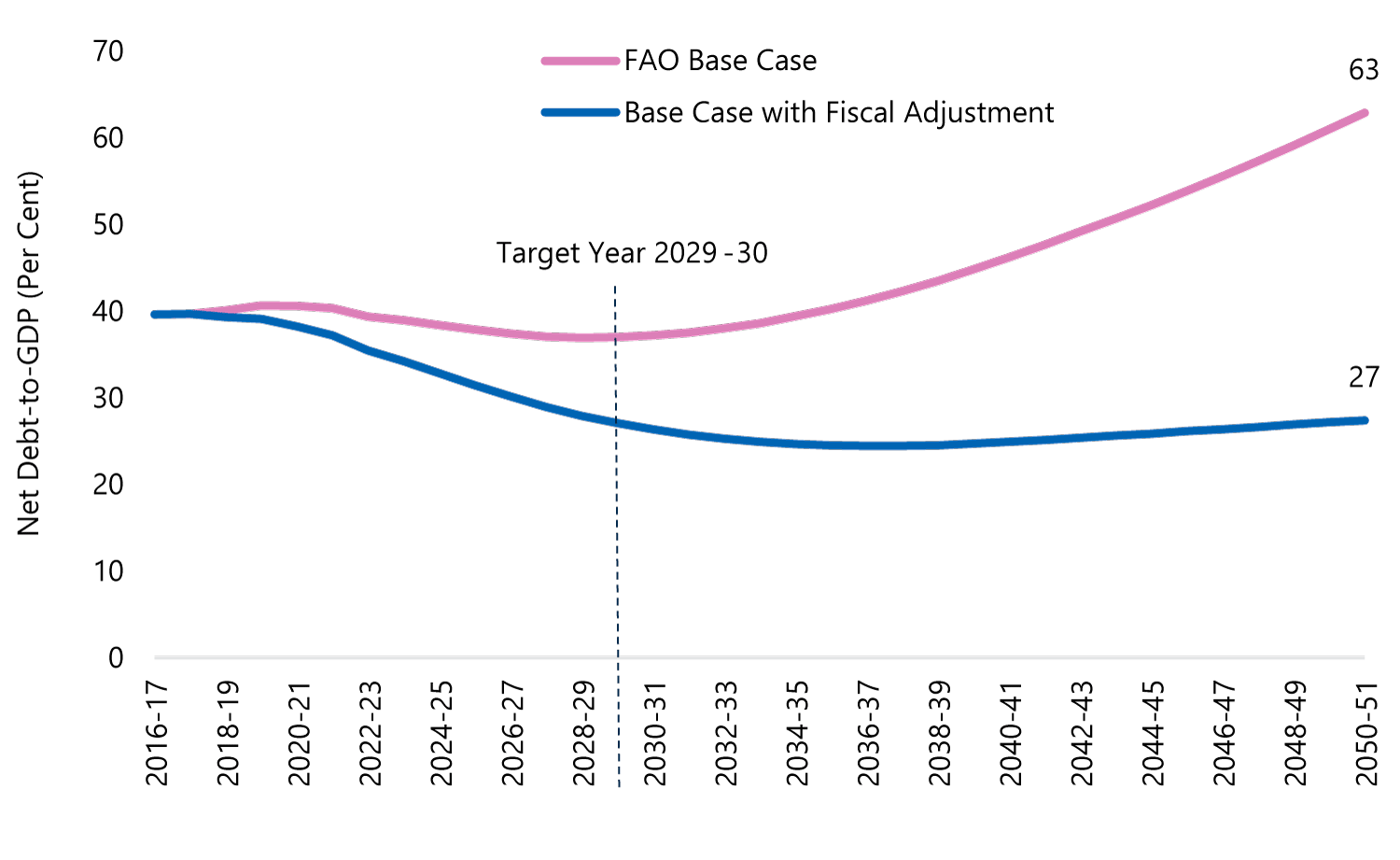
Source: Ontario Public Accounts, Statistics Canada and FAO.
Despite modest deficits in the 2030s and 2040s, achieving the Province’s 27 per cent goal by 2029-30 stabilizes Ontario’s public finances, with the net debt-to-GDP ratio remaining close to 27 per cent over the remainder of the projection to 2050-51.
Maintaining a 40 per cent Net Debt-to-GDP Ratio
Given the large fiscal adjustment required to achieve the government’s 27 per cent debt-to-GDP target, a potential alternative target might be to maintain Ontario’s net debt-to-GDP ratio at its current value of about 40 per cent. In this case, the FAO estimates that the government would need to make a more moderate fiscal adjustment of at least 0.5 per cent of GDP beginning in 2018-19. This is equivalent to a $4.1 billion fiscal adjustment in 2018-19, that increases with GDP growth over the projection.
A fiscal adjustment of this size would result in small and relatively stable annual budget deficits until about 2026-27. However, demographic pressures would still result in a significant increase in budget deficits in the 2030s and 2040s.
Deficits expected throughout projection, even with a fiscal adjustment of 0.5 per cent of GDP beginning in 2018-19
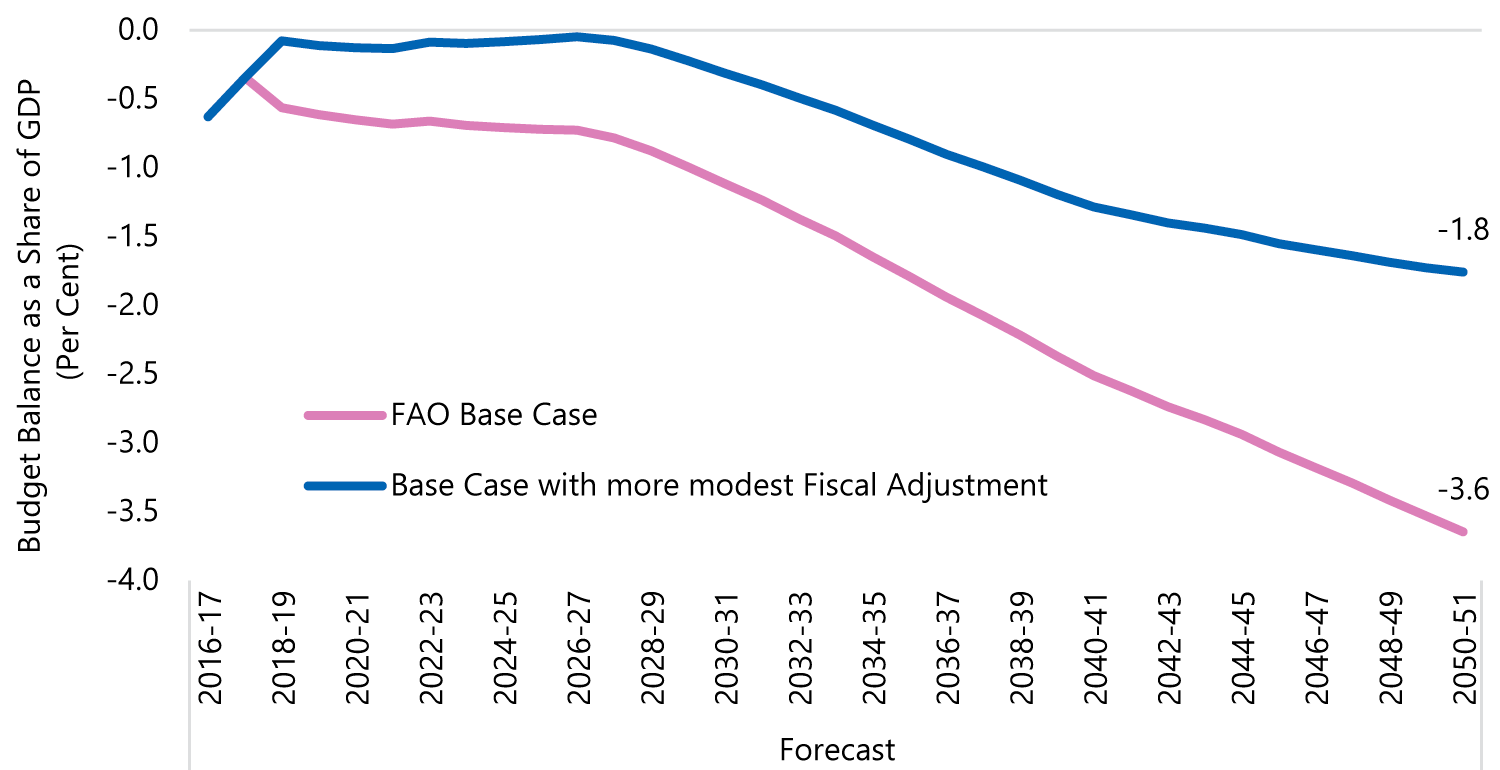
Source: Ontario Public Accounts, Statistics Canada and FAO.
A fiscal adjustment of 0.5 per cent of GDP would allow much of the demographic pressures in the 2020s to be accommodated, and lowers the net debt-to-GDP ratio to around 30 per cent by the early 2030s. However, this smaller fiscal adjustment would not be sufficient to prevent rising deficits from pushing the net debt-to-GDP ratio back up to 40 per cent by 2050-51.
A permanent fiscal adjustment of 0.5 per cent of GDP would not be sufficient to stabilize net debt-to-GDP
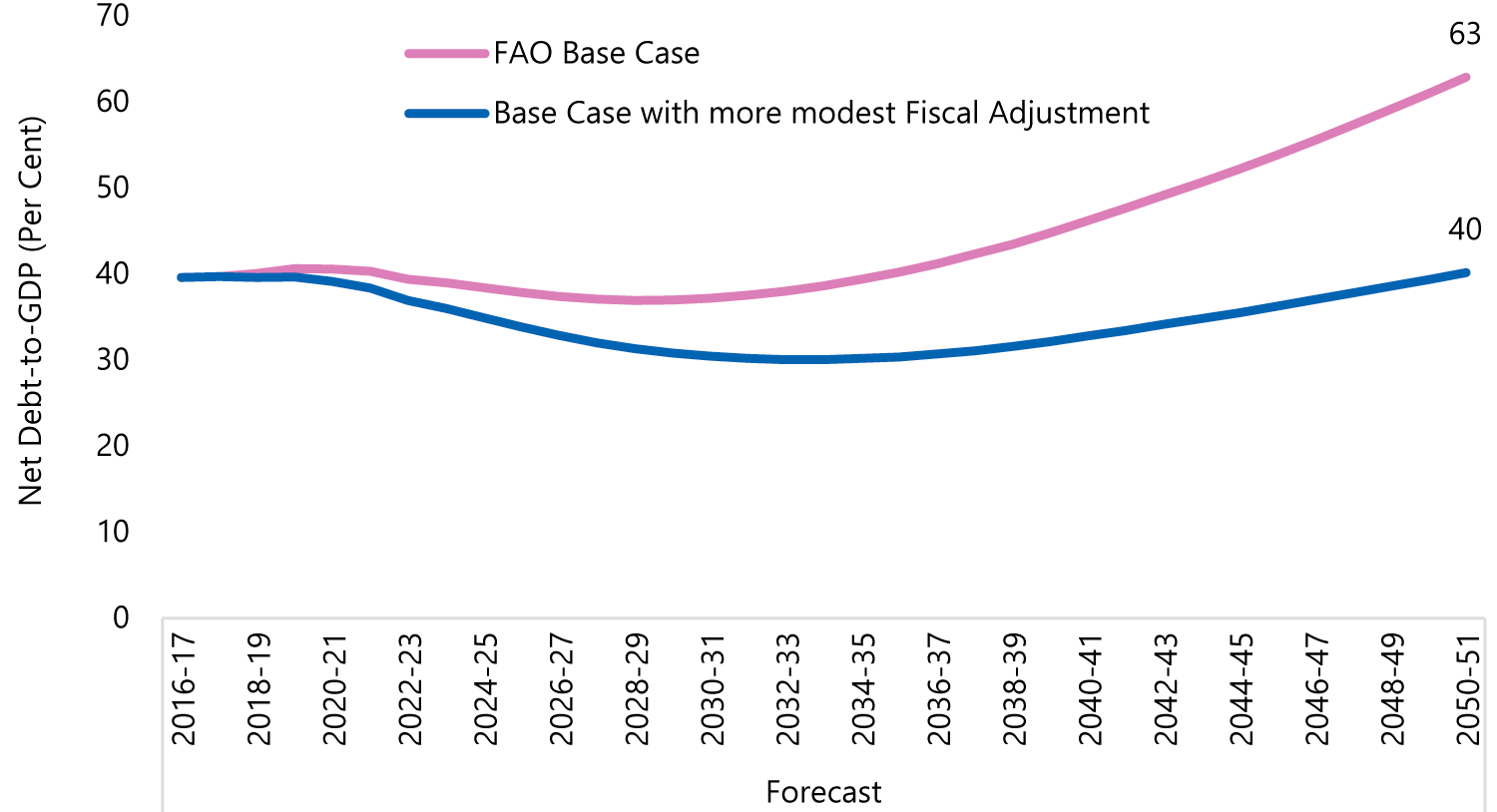
Source: Ontario Public Accounts, Statistics Canada and FAO.
5.3 The Implications of Postponing the Fiscal Adjustment
Since the demographic pressures on the budget do not intensify until the mid-2020s and into the 2030s, it could be tempting for Ontario governments to ignore the needed shift in fiscal policy in the short term. But the longer the government waits to deal with the coming demographic pressures, the costlier it will be for Ontarians in the future to stabilize the debt burden.
Delaying action increases the size of the required fiscal adjustment
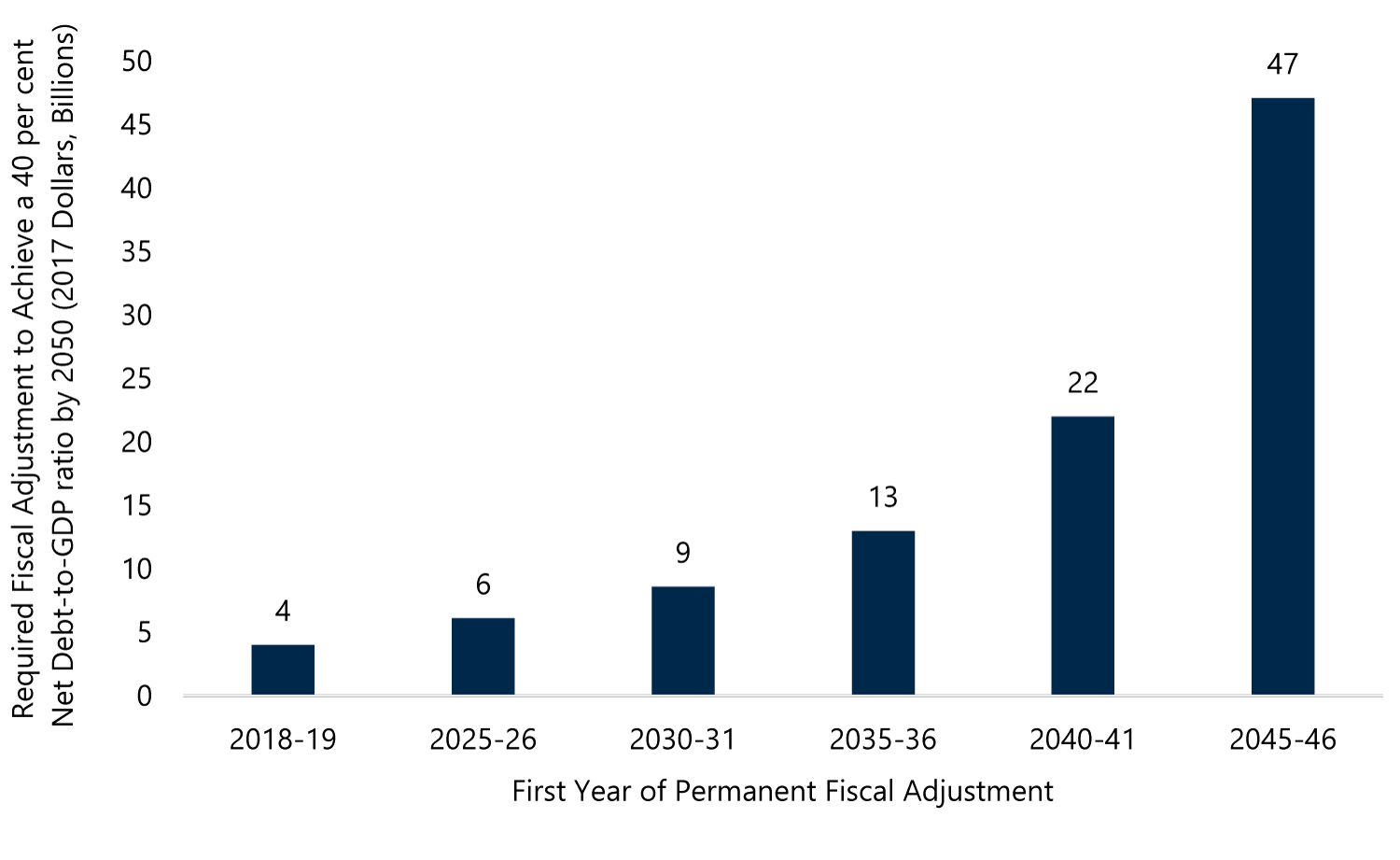 Note: this analysis does not incorporate the economic feedback associated with a fiscal adjustment.
Note: this analysis does not incorporate the economic feedback associated with a fiscal adjustment.
Source: FAO.
To achieve a 40 per cent net debt-to-GDP ratio by 2050-51, the FAO estimates that the government would need to make a permanent fiscal adjustment of 0.5 per cent of GDP beginning in 2018-19 (equivalent to $4.1 billion in that year).
If the government waited until 2025-26 to act, the adjustment required in that year would be $6.0 billion (in 2017 dollars) to achieve the same goal. If the government waited until 2040-41, the required adjustment in the first year would be $22 billion (in 2017 dollars).
Importantly, postponing the fiscal adjustment not only increases the size of the adjustment, but also changes who would pay to achieve it.
To some extent, all Ontarians pay taxes and benefit from government services, both directly and indirectly. But Ontarians of different ages tend to pay different amounts of tax and also benefit from different amounts of government services.
The average Ontario citizen tends to pay higher amounts of personal income tax as they gain experience and earn higher wages. This pattern continues until about age 60 when individuals begin to scale back their work and eventually retire. After retirement, not surprisingly, Ontarians typically pay less personal income tax.
However, provincial government spending varies by age in a different way. For instance, health expenditure per capita starts off high for newborns and very young children before declining sharply through the youth and core working years. Health spending per person remains relatively low until approximately age 60, after which it begins rising rapidly as people move into their senior years and require more health care services.
After age 60, per capita health expenditure rises while per capita provincial personal income tax falls
 Source: Canada Revenue Agency, Canadian Institute for Health Information and FAO. Data are for the year 2014, the latest avialable for both series.
Source: Canada Revenue Agency, Canadian Institute for Health Information and FAO. Data are for the year 2014, the latest avialable for both series.
In 2017, the baby boomers are between the ages of about 50 and 70, and transitioning out of their prime income tax paying years. The generation X cohort (approximately aged 35 to 50) are in the middle of their careers while echo boomers (approximately aged 15 to 35) are nearer the beginning of their working life.
While personal income tax and health spending are only two categories of revenue and expenditure, they demonstrate that the later the Province waits to raise revenue or lower spending, the more the baby boomers would avoid the cost of fiscal adjustment, and the greater the burden would be for younger Ontarians.
6. Dealing with Uncertainty in the Long-term Projections
6.1 Key Points
- As a result of unexpected technological developments, climate change or other global issues, the next 35 years could look very different than the economic and fiscal outlook presented in the FAO’s base case projection.
- Because of this uncertainty, the FAO developed a low growth scenario to assess the fiscal impact of a less favourable economic outlook. In the low growth scenario,
- Lower productivity gains and economy-wide price inflation lead to lower nominal GDP growth;
- Ontario nominal GDP growth averages 3.5 per cent per year over the outlook, below the 3.9 per cent growth projected in the base case;
- Ontario’s net debt-to-GDP rises to 95 per cent by 2050-51.
- The FAO also developed a high growth scenario, in which nominal GDP growth averages 4.3 per cent over the projection.
- The high growth scenario assumes that productivity growth permanently returns to levels not seen since the 1990s, resulting in much higher growth than experienced over the past 25 years.
- As a result, Ontario’s net debt-to-GDP steadily declines to 33 per cent by 2050-51.
- Changes in revenue or expense policies in the near term can have a significant impact on Ontario’s long-term net debt-to-GDP ratio. There are also factors beyond the Province’s control that can have a significant impact on the Province’s long-term fiscal position, such as the growth in federal transfers or the future path of interest rates.
6.2 Uncertainty in the Base Case
A 33-year demographic and economic projection requires many assumptions, each involving significant uncertainty. Many unanticipated events and developments could have a material impact on the Ontario economy over the next few decades.
Trade and Protectionism
Rising protectionist sentiment in the US and in Europe could reverse the decades long trend of rising global integration which has supported economic growth. An increase in isolationist policies would represent a risk for the global economic outlook and for Ontario. In particular, there are significant risks for Ontario with respect to the proposed renegotiation of the North American Free Trade Agreement (NAFTA) and the adoption of protectionist trade measures in the United States.
Technological Change
Globalization and accelerating technological change is expected to impact the nature of employment, as growth in non-standard and precarious employment increases, frequently at the expense of more traditional permanent jobs. Precarious employment has the potential to impact tax revenue growth in the long term, while technological advances could dramatically change Ontario’s future industrial composition.
Climate Change and Carbon Reduction Policies
The Ontario government has committed to reducing greenhouse gas emissions to 80 per cent below their 1990 levels by 2050. Climate change and carbon reduction policies to combat climate change will have an impact on the economy, incomes, and tax revenues. The FAO’s base case economic projection implicitly assumes that the low-carbon transition will not adversely impact Ontario’s long-term growth prospects.
Climate change could also increase the frequency and intensity of natural disasters, which would impact the Ontario economy and would also require increased provincial spending for disaster mitigation, assistance and recovery.
Rising Income Inequality
Rising income inequality over the long run could potentially reduce economic growth. According to the IMF, reducing income inequality is “… correlated with faster and more durable growth.”[35] Since 1976, income inequality in Ontario has increased, with the share of income earned by the top 20 per cent of earners rising from 45 per cent to about 53 per cent in 2015 while other income groups saw their respective income shares decline.[36]
The FAO’s base case implicitly assumes that inequality between wage earners will not impact the economic projection.
6.3 Alternative Economic Scenarios
To account for the uncertainty inherent in long-term economic projections, the FAO developed high and low growth scenarios. These alternative scenarios are built on a reasonable set of alternate assumptions for key economic variables.[37]
In all three scenarios, Ontario’s population continues to age and the share of seniors is still projected to be much higher over the outlook than in 2016.
In the low growth scenario, the U.S. economy is assumed to grow more slowly than in the base case. In this scenario, the U.S. economy does not recover to pre-crisis growth rates, interest rates stay low, the Canadian dollar trends to 85 cents by 2050, and oil prices are assumed to remain constant in real terms.
The high growth scenario assumes higher productivity and economic growth in Ontario than in the base case, supported by stronger U.S. growth. This scenario includes higher long-term interest rates, a stronger Canadian dollar, and higher oil prices.
Summary of Alternative Economic Scenarios
|
Average Growth (Per Cent) |
Actual (Average) |
High |
Base |
Low |
|---|---|---|---|---|
|
1992-2015 |
2016-50 |
2016-50 |
2016-50 |
|
|
Nominal GDP |
4.1 |
4.3 |
3.9 |
3.5 |
|
GDP Deflator |
1.6 |
2.0 |
1.9 |
1.8 |
|
Real GDP |
2.5 |
2.3 |
2.0 |
1.7 |
|
Labour Force |
1.2 |
0.9 |
0.8 |
0.7 |
|
Labour Productivity |
1.3 |
1.3 |
1.1 |
0.9 |
|
Employment |
1.4 |
1.0 |
0.9 |
0.8 |
|
Unemployment Rate * |
7.7 |
5.5 |
5.9 |
6.6 |
|
Population |
1.2 |
1.0 |
0.9 |
0.9 |
|
Consumer Price Index |
1.8 |
2.0 |
2.0 |
1.9 |
*Unemployment Rate is per cent of labour force unemployed
Source: Statistics Canada and FAO.
6.4 Fiscal Implications of Alternative Scenarios
In the low growth scenario, revenue growth would be lower than projected in the base case. Despite lower interest rates, the deficit would increase compared to the base case and Ontario’s net debt-to-GDP ratio would rise to 95 per cent by 2050-51.
In the high growth scenario, Ontario’s revenue growth would be much higher, and the Province’s deficits would remain modest over the projection. While Ontario’s net debt-to-GDP ratio would not reach the 27 per cent target set out by the Province, the relatively small deficits and strong GDP growth would reduce the net debt-to-GDP ratio to 33 per cent by 2050-51.
Net Debt-to-GDP Ratio by Economic Growth Scenario
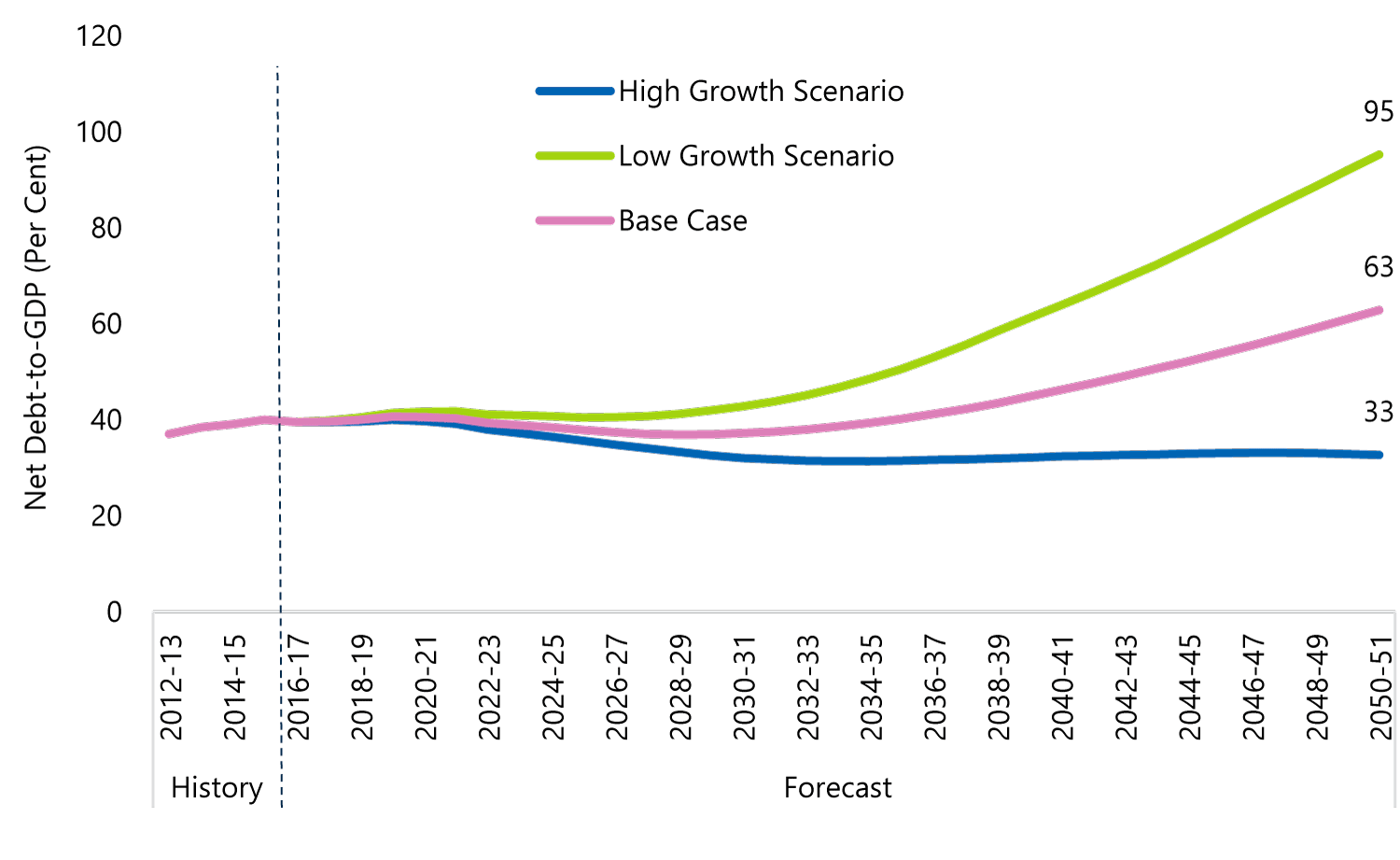 Source: Ontario Public Accounts and Budgets, Statistics Canada and FAO.
Source: Ontario Public Accounts and Budgets, Statistics Canada and FAO.
The FAO assumed that population growth and price inflation would be similar in all three scenarios. This implies that while government revenues vary in each scenario, government spending does not. The FAO assumes that the government maintains the same fiscal policies in all three scenarios. These outcomes could be different to the extent that governments choose to adjust fiscal policy in response to higher or lower revenue growth.[38]
6.5 Fiscal and Economic Sensitivities
The FAO’s base case projection assumes that current fiscal policies remain largely unchanged. However, changes in revenue or expense policies in the near term can have a significant impact on Ontario’s long-term net debt-to-GDP ratio. There are also factors beyond the Province’s control that can have a significant impact on the Province’s long-term fiscal position, including the growth rate of federal transfers or the future path of interest rates.
To gauge the sensitivity of Ontario’s long-term fiscal position to changes in key variables, the FAO estimated the impact to Ontario’s net debt-to-GDP ratio in 2050-51 of changes in four broad areas, tax policy, spending, federal transfers and interest rates.
For example, if the government permanently raised personal income taxes (PIT) to earn five per cent more PIT revenue in 2018-19 (which is roughly an additional $258 per taxpayer in that year), Ontario’s net debt-to-GDP ratio would fall by 11 percentage points by 2050-51, compared to the FAO’s base case.
For spending, if the government was able to reduce the growth rate of health care spending by 0.1 per cent in each year of the projection[39], Ontario’s net debt-to-GDP ratio would improve by six percentage points in 2050-51.
Sensitivity of Net Debt-to-GDP Ratio in 2050 to Select Factors
|
Change Beginning in 2018-19 |
change from base case in 2050-51 net debt-to-GDP, all else equal |
|---|---|
|
Taxation |
|
|
A sustained change of +/- 5 per cent of Personal Income Tax revenues ($258 per tax filer in 2018-19) over the projection |
+/- 11 percentage points |
|
A sustained change of +/- 1 percentage point in the general Corporations Tax rate over the projection |
+/- 6 percentage points |
|
A sustained change of +/- 0.5 percentage points in the HST rate over the projection |
+/- 9 percentage points |
|
Health Care Spending |
|
|
Sustained change of +/- 0.1 per cent in the growth rate of health care spending over the projection |
+/- 6 percentage points |
|
Federal Transfers |
|
|
Sustained change of +/- 0.5 per cent in the annual growth of the Canada Health Transfer over the projection |
+/- 7 percentage points |
|
Sustained change of +/- 0.5 per cent in the annual growth of the Canada Social Transfer over the projection |
+/- 2 percentage points |
|
Interest Rates |
|
|
Sustained change of +/- 0.5 percentage points in Ontario’s borrowing rate over the projection |
+/- 8 percentage points |
Note: these are static impacts, and do not incorporate any economic feedback effects.
Source: FAO.
If the federal government increased the growth rate of the Canada Health transfer by 0.5 per cent per year over the projection, beginning in 2018-19, Ontario’s net debt-to-GDP would improve by seven percentage points by 2050-51.
Lastly, Ontario’s fiscal position is very sensitive to the future path of interest rates. If the average government of Ontario borrowing rate was 0.5 percentage points lower in the FAO’s base case (beginning in 2018-19), the Province’s net debt-to-GDP ratio would be eight percentage points lower by 2050-51 due to the lower debt interest payments over the projection.
7. Appendices
7.1 Components of the FAO Base Case Fiscal Projection
|
Component |
Actual (Average) |
Projection (Average) |
||||
|---|---|---|---|---|---|---|
|
1992-93 to 2015-16 |
2016-17 to 2020-21 |
2021-22 to 2030-31 |
2031-32 to 2040-41 |
2041-42 to 2050-51 |
2016-17 to 2050-2051 |
|
|
Total Revenue |
16.4 |
16.4 |
16.2 |
16.1 |
16.1 |
16.2 |
|
Tax Revenue |
12.3 |
11.9 |
12.0 |
12.0 |
12.1 |
12.0 |
|
Personal Income Tax |
4.3 |
4.2 |
4.4 |
4.5 |
4.7 |
4.5 |
|
Corporations Tax |
1.9 |
1.6 |
1.6 |
1.7 |
1.6 |
1.6 |
|
Harmonized Sales Tax |
2.8 |
3.1 |
3.0 |
3.1 |
3.1 |
3.1 |
|
Other Tax Revenue |
3.3 |
3.0 |
2.9 |
2.7 |
2.7 |
2.8 |
|
Transfer Revenue |
2.4 |
2.9 |
2.6 |
2.6 |
2.5 |
2.6 |
|
Other Revenue |
1.7 |
1.7 |
1.6 |
1.5 |
1.5 |
1.6 |
|
Total Expense |
17.3 |
17.0 |
17.0 |
18.0 |
19.2 |
17.9 |
|
Program Expense |
15.4 |
15.6 |
15.4 |
15.9 |
16.2 |
15.8 |
|
Health |
5.9 |
6.5 |
6.9 |
7.9 |
8.7 |
7.6 |
|
Education |
3.0 |
3.2 |
3.1 |
3.1 |
3.0 |
3.1 |
|
Other Program Expense |
6.4 |
6.0 |
5.4 |
4.9 |
4.5 |
5.1 |
|
Public Debt Interest |
1.9 |
1.4 |
1.6 |
2.1 |
3.0 |
2.1 |
|
Surplus (Deficit) Before Reserve |
-0.9 |
-0.6 |
-0.8 |
-1.9 |
-3.1 |
-1.7 |
|
Net Debt |
33.5 |
40.1 |
38.1 |
41.2 |
54.9 |
44.1 |
Note: The FAO uses three different publicly available sources for fiscal data. From 2000-01 to 2015-16, the FAO uses public accounts or budget data. However, since historical public accounts data often faces accounting changes and reclassficiations, the FAO uses data from Statistics Canada and the Canadian Institute For Health Information, who make adjustments to the data to improve comparability. The FAO applies the growth rates from these data sources to public accounts data to extend these data back to 1991-92.
Sources: Ontario Public Accounts and Budgets, Statistics Canada and FAO.
7.2 FAO Economic Base Case and Consensus Projections
|
Average Growth |
Actual |
Projection |
|||||
|---|---|---|---|---|---|---|---|
|
1992-2015 |
2001-2015 |
2016-2020 |
2021-2030 |
2031-2040 |
2041-2050 |
2016-2040 |
|
|
Nominal GDP |
|||||||
|
FAO Base Case |
4.1 |
3.6 |
4.1 |
3.8 |
3.9 |
3.8 |
3.9 |
|
Consensus* Average |
4.1 |
4.0 |
4.0 |
- |
4.0 |
||
|
Ontario Finance** |
3.9 |
4.0 |
4.0 |
- |
4.0 |
||
|
GDP Deflator |
|||||||
|
FAO Base Case |
1.6 |
1.9 |
1.8 |
1.8 |
1.9 |
1.9 |
1.9 |
|
Consensus Average |
1.8 |
2.1 |
2.0 |
- |
2.0 |
||
|
Ontario Finance |
1.7 |
2.0 |
2.0 |
- |
1.9 |
||
|
Real GDP |
|||||||
|
FAO Base Case |
2.5 |
1.7 |
2.2 |
1.9 |
2.0 |
1.9 |
2.0 |
|
Consensus Average |
2.3 |
1.9 |
2.0 |
- |
2.0 |
||
|
Ontario Finance |
2.2 |
2.0 |
2.0 |
- |
2.1 |
||
|
Labour Force |
|||||||
|
FAO Base Case |
1.2 |
1.2 |
0.9 |
0.8 |
0.9 |
0.7 |
0.9 |
|
Consensus Average |
1.1 |
0.7 |
0.8 |
- |
0.8 |
||
|
Ontario Finance |
1.0 |
0.8 |
0.8 |
- |
0.8 |
||
|
Labour Productivity |
|||||||
|
FAO Base Case |
1.3 |
0.9 |
1.1 |
1.1 |
1.1 |
1.1 |
1.1 |
|
Consensus Average |
1.1 |
1.2 |
1.2 |
- |
1.2 |
||
|
Ontario Finance |
1.0 |
1.2 |
1.2 |
- |
1.2 |
||
|
Employment |
|||||||
|
FAO Base Case |
1.4 |
1.2 |
1.1 |
0.8 |
0.9 |
0.8 |
0.9 |
|
Consensus Average |
1.2 |
0.7 |
0.8 |
- |
0.8 |
||
|
Ontario Finance |
1.2 |
0.8 |
0.8 |
- |
0.9 |
||
|
Unemployment Rate (per cent of labour force unemployed) |
|||||||
|
FAO Base Case |
7.7 |
7.2 |
6.3 |
6.0 |
5.8 |
5.6 |
6.0 |
|
Consensus Average |
6.6 |
6.1 |
5.8 |
- |
6.1 |
||
|
Ontario Finance |
6.3 |
5.9 |
5.6 |
- |
5.8 |
||
|
Population |
|||||||
|
FAO Base Case |
1.2 |
1.1 |
1.2 |
1.1 |
0.9 |
0.7 |
1.0 |
|
Consensus Average |
1.1 |
1.0 |
0.8 |
- |
1.0 |
||
|
Ontario Finance |
1.2 |
1.1 |
0.9 |
- |
1.0 |
||
|
Consumer Price Index |
|||||||
|
FAO Base Case |
1.8 |
2.0 |
2.1 |
2.0 |
2.0 |
2.0 |
2.0 |
|
Consensus Average |
2.0 |
2.0 |
1.9 |
- |
2.0 |
||
|
Ontario Finance |
2.0 |
2.0 |
2.0 |
- |
2.0 |
||
* FAO consensus includes forecasts from the Centre for Spacial Economics, the University of Toronto’s Policy and Economic Analysis Program and the Conference Board of Canada.
** Ontario Finance numbers are based on: Ontario’s Long-term Report on the Economy, published in 2017.
Sources: Statistics Canada, FAO, Ontario Finance, and consensus forecasters.
7.3 Defining Ontario’s Generations
When describing a long-term demographic outlook, it is helpful to refer to different population age cohorts. However, with the exception of the baby boomer cohort, there is little consensus on how to define Ontario’s generations, with various publications setting the boundaries between generations differently. For the purposes of this report, the FAO has defined Ontario’s generations as follows:
- The pre-World War II generation refers to older Ontarians born during and before the Second World War.
- The “baby boomers” are the generation of people born between 1946 and 1965, when returning soldiers from World War II settled down and had families. This period was marked by very high fertility rates and rapid population growth.
- Generation X is defined as those born between 1966 and 1980, a period of declining fertility and slower population growth.
- The “echo boom” generation is defined as those born between 1981 and 2000. For the most part, these are the children of the baby boomers, and are also known as “millennials” or “generation Y”.
- Generation Z is defined as those born between 2001 and 2015.
Except for the baby boom generation, these definitions are somewhat different than Statistics Canada’s definitions.[40] For this report, the boundaries between generation X, the echo boomers, and generation Z were chosen to include between 15 and 20 years of births, to enclose periods of distinct demographic characteristics (i.e. periods of higher and lower population growth), and to facilitate the discussion of each generation’s fiscal and economic impacts in each decade of the projection period.
Ontario’s Age Distribution in 2016
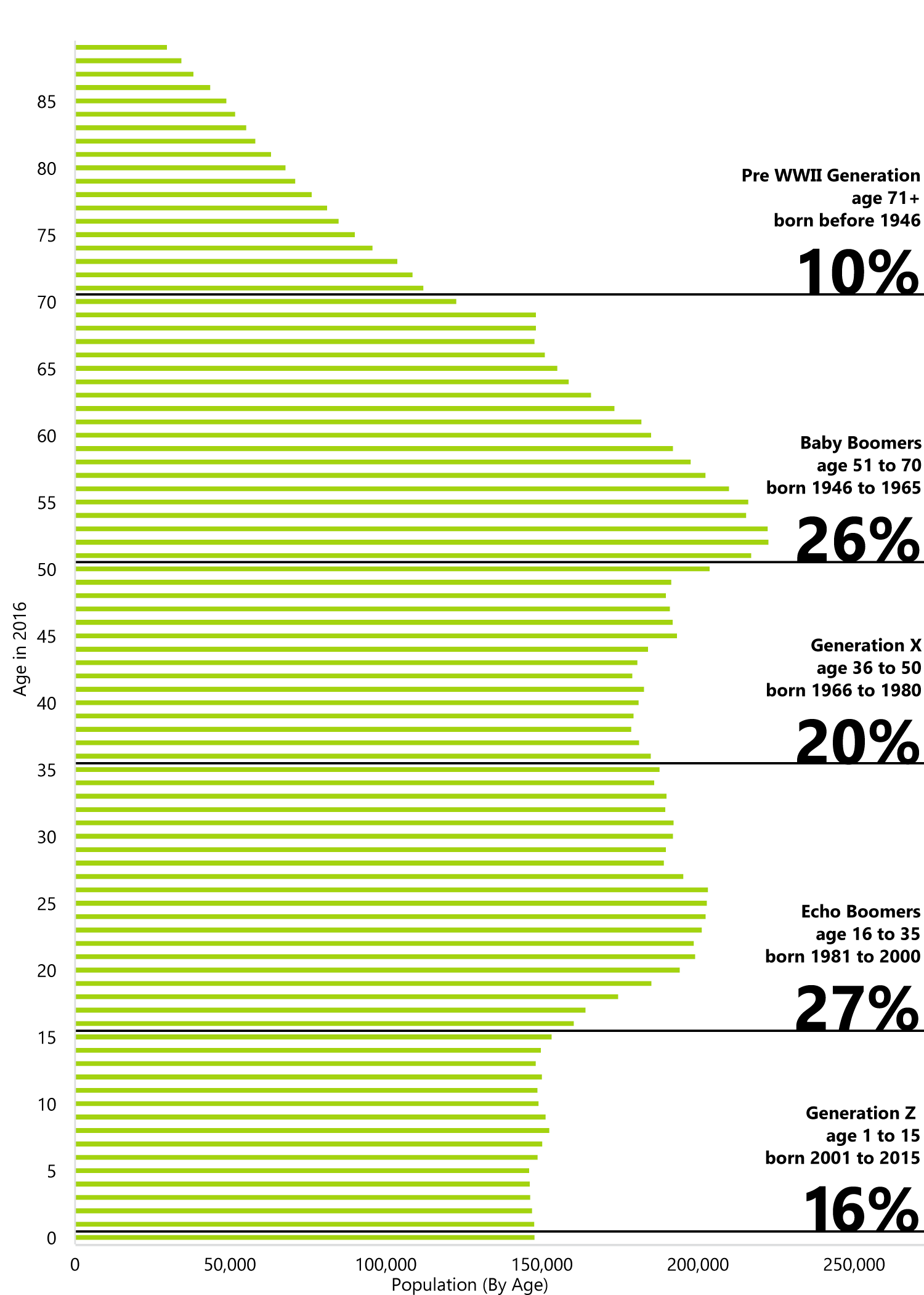 Source: Statistics Canada and FAO.
Source: Statistics Canada and FAO.
Ontario’s Age Distribution in 2030
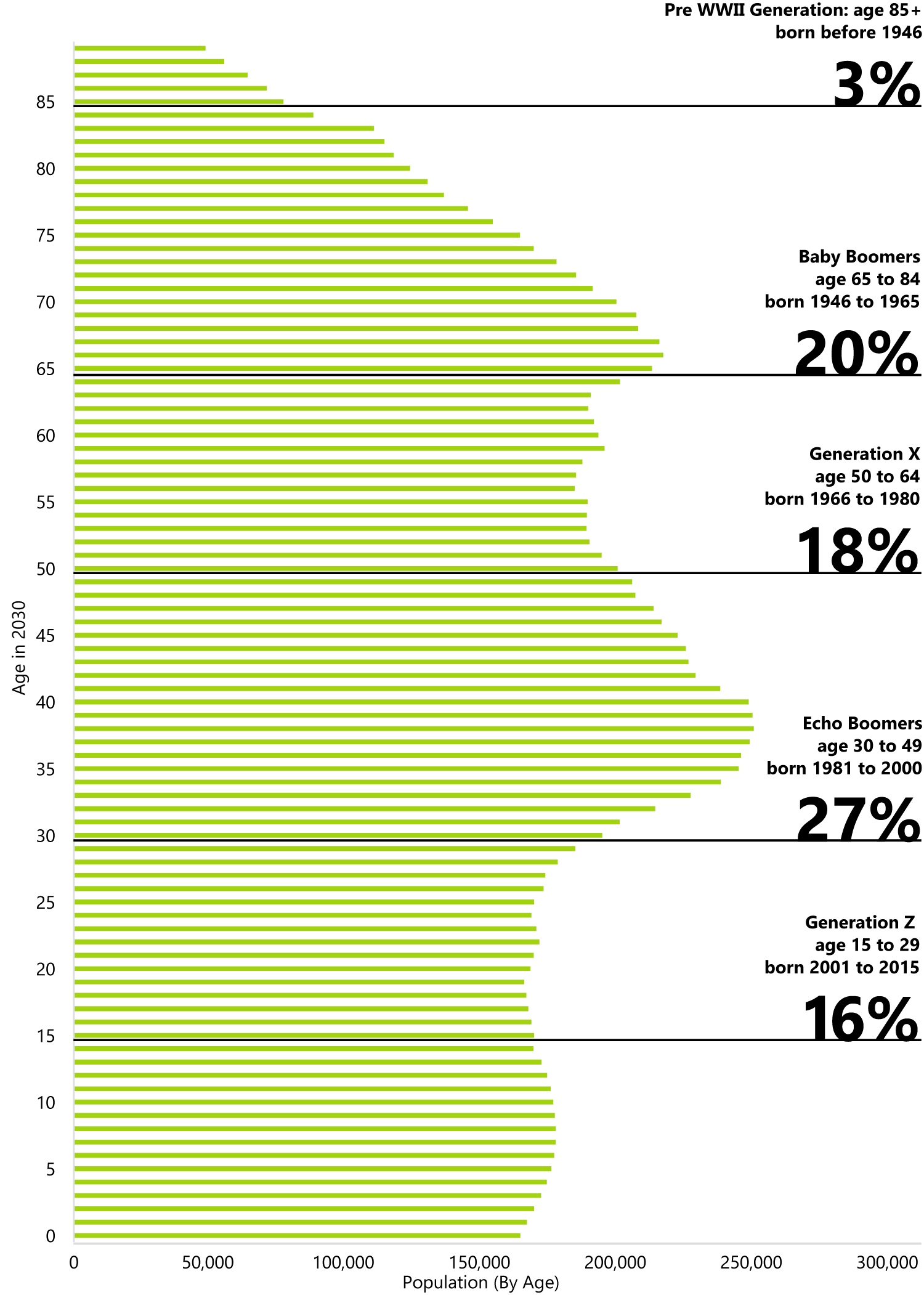 Source: Statistics Canada and FAO.
Source: Statistics Canada and FAO.
Ontario’s Age Distribution in 2050
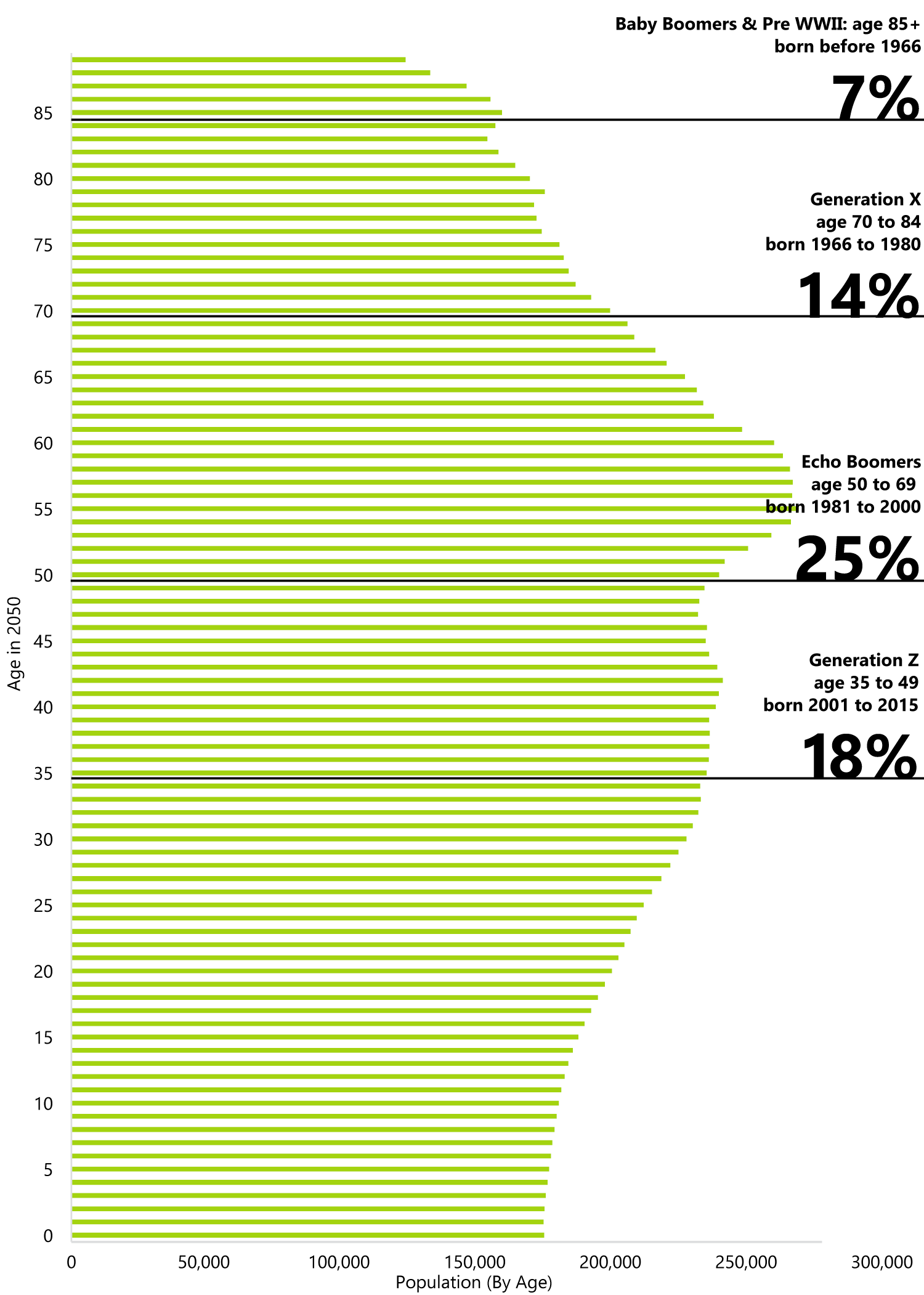 Source: Statistics Canada and FAO.
Source: Statistics Canada and FAO.
7.4 Fiscal Adjustment and Economic Feedback
Beginning with the base case projection, the FAO estimated the required fiscal policy changes (either raising revenue or lowering spending) that would result in a net debt-to-GDP target of 27 per cent by 2029-30. Specifically, the FAO estimates that the government would need to permanently increase revenue and/or reduce spending by at least 0.75 per cent of GDP beginning in 2018-19 to achieve a net debt-to-GDP ratio of 27 per cent by 2029-30. In 2018-19, this would amount to a $6.5 billion fiscal adjustment, which grows with nominal GDP over the projection.
This fiscal adjustment is introduced into the FAO’s base case projection by imposing both a tax increase and spending cut that total 0.75 per cent of GDP, beginning in 2018-19. The tax increase permanently raises revenues above the base case, while the spending cut permanently lowers spending below the base case.
For the tax increase, the FAO raised tax revenue by 0.38 per cent of GDP beginning in 2018-19 (half the required fiscal adjustment). This amounts to a $3.3 billion tax increase in 2018-19, which grows over the projection along with nominal GDP.
Total revenue as a share of GDP with and without the tax increase
 Source: Ontario Public Accounts, Statistics Canada and FAO.
Source: Ontario Public Accounts, Statistics Canada and FAO.
Similarly, program spending was reduced by 0.37 per cent of GDP beginning in 2018-19 ($3.2 billion in 2018-19). As with the revenue adjustment, this spending cut also grows with nominal GDP over the projection.
However, to the extent that this fiscal adjustment involves higher taxes or lower spending in Ontario, these policy changes would be expected to result in negative economic impacts. If the government raised taxes, households and business have less money to spend and invest, which would lower the demand for goods and services in the short term. This in turn, would lower government revenue, and make the net debt-to-GDP target harder to achieve.
When this economic feedback is included, the FAO estimates that the required fiscal adjustment (to achieve a net debt-to-GDP ratio of 27 per cent by 2029-30) increases from 0.75 per cent of GDP to almost 0.9 per cent of GDP. This implies that the required fiscal adjustment would rise from $6.5 billion to $7.6 billion in 2018-19.
However, it is difficult to precisely estimate the economic feedback from future fiscal policy changes. For example, if the government cut spending by $7.6 billion dollars in 2018, and laid off a significant number of employees, Ontario’s unemployment rate would rise relative to where it would otherwise have been. This would likely lead to reduced consumer spending and more moderate consumer price inflation in Ontario. But, how would the Bank of Canada respond to this economic shock, and how would the Canadian dollar respond? Similarly, how would private sector wages respond to this shift in Ontario’s labour market? How would inter-provincial migration respond?
While the economic feedback from higher taxes or lower spending would certainly make achieving a fiscal target harder, it is challenging to precisely quantify the impact.
As a result, the FAO presents its fiscal adjustment analysis excluding any economic feedback. As such, the FAO’s estimates of the required fiscal adjustment should be viewed as a lower bound of the actual fiscal policy changes required.
7.5 The FAO’s Economic and Fiscal Modelling System
The FAO has developed a system of demographic, economic and fiscal models that form the foundation for the long-term projections presented in this report. The system includes two separate but integrated models:
- A long-term macroeconomic model for Ontario that includes a detailed demographic sub-model as well as a system of equations describing Ontario’s aggregate economic output.
- An Ontario fiscal model that provides estimates of detailed components of provincial revenues, program spending and debt based on the demographic and economic projections provided by the macroeconomic model.
These models ensure analytical consistency between the various aspects of the FAO’s long-term projections while also providing a framework for economic and fiscal scenario analysis.
The Demographic and Economic Model of Ontario (ELMO)
ELMO (Economic Long-term Model for Ontario) is an annual model developed by the FAO to produce long-term projections of detailed demographic and economic indicators. The model includes equations describing the Ontario economy’s aggregate output or supply, demand components, labour market indicators, prices and incomes. The model also includes a block of equations describing key economic indicators for the rest-of-Canada.
ELMO provides projections for key economic concepts -- including population growth, consumer prices, nominal GDP, wages and profits -- which are required by the FAO’s fiscal model.
Demographic Sub-Model
ELMO contains a detailed demographic sub-model, which adopts fertility and mortality rates provided by the Ontario Ministry of Finance, as well as assumptions for international and inter-provincial migration, developed by the FAO. These enable the FAO to produce a detailed demographic projection by age and sex for Ontario. ELMO’s detailed demographic projections are a key input for the fiscal model’s estimates of government spending by category.
Supply-Side of the Economy
The model’s demographic projection combined with labour force participation rates generate a projection for Ontario’s labour force. This, combined with a labour productivity assumption, underpins the supply-side of the model. This estimate of Ontario’s potential economic growth constrains the long-term projection for real GDP growth.
Aggregate Demand
ELMO’s demand-side equations include each of the major categories of expenditure-based GDP (consumption, investment, exports, imports), each linked to appropriate economic concepts. (For example, Ontario exports are driven by US economic growth, while household spending is driven by incomes, relative prices, and changes in the unemployment rate). The equations describing aggregate demand rely on external assumptions for US growth, interest rates, and the Canada-US exchange rate.
Price, Income, Production, and Rest-of-Canada Blocks
The model also includes a price block to derive consumer price inflation and the GDP deflator. These are based on external commodity prices, the Canada-US exchange rate, and Ontario wage growth.
The income-block provides estimates of income-based GDP components including wages, profits, mixed income and indirect taxes. Many of these components are used by the fiscal model to drive the tax revenue projection.
The production block includes the private sector and “total government” sector, and is used to estimate industrial production, which, combined with the productivity assumption, determines total employment.
The “rest-of-Canada” block is a small sub-model combining all of the other provinces. It estimates real and nominal GDP, population, employment, labour force and prices. It is used to drive inter-provincial trade and migration between Ontario and other provinces.
Fiscal Outlook Model of Ontario (FOMO)
The FAO’s fiscal model - FOMO – is used to develop projections of Ontario’s fiscal position given an economic and demographic forecast, and allows for an assessment of the fiscal impact of different economic, demographic and policy scenarios. The model is divided into three separate blocks of equations covering provincial revenues, expenses, and debt.
Revenues
FOMO provides estimates of all major sub-categories of revenue, including taxation, federal transfers, income from government business enterprises and other revenue. Major tax sources (e.g. PIT, CIT, HST) are projected based on historical relationships with appropriate economic drivers (personal income, corporate profits and household consumption). Similarly, income from government business enterprises and other non-tax revenue are projected based on historical relationships with nominal GDP.
Major federal transfers are projected based on current federal funding formulas while other transfers are assumed to grow in line with nominal GDP.
Expenses
FOMO provides projections of operating and capital expenses for health, education, post-secondary education and training, children’s and social services, justice and other programs. For each sector, operating and capital spending are projected based on their relationships with key economic and demographic drivers, including population growth, price inflation, and past rates of public service enrichment (which accounts for the evolving nature of public services).
For example, primary and secondary education spending is estimated by combining the projection of the student-age population with a projection of costs per student. The student-age population is provided by ELMO’s demographic sub-model while per student costs are projected based on CPI inflation and an enrichment rate.
Total operating spending in each category includes an estimate of amortization expense based on the net capital stock of each sector. Capital stock estimates are developed for each category based on capital expenditures, net of amortization.
Interest on debt payments are modelled based on gross debt, annual borrowing requirements and an interest rate forecast.
Debt
The revenue and expense forecasts are combined to provide a projection of the budget balance and debt. Estimates of the budget balance, capital expenditures, amortization, debt maturities, financial and tangible assets are used to calculate Ontario’s accumulated deficit, net borrowing requirements, and gross and net debt levels.
Further Details
We encourage interested readers to contact the FAO for additional technical details on the FAO’s long-term projections and the FAO’s modeling system. Please email the FAO’s chief economist, David West, dwest@fao-on.org.
About this Document
Established by the Financial Accountability Officer Act, 2013, the Financial Accountability Office (FAO) provides independent analysis on the state of the Province’s finances, trends in the provincial economy and related matters important to the Legislative Assembly of Ontario. The FAO’s Long-Term Budget Outlook will be released every two years, providing an assessment of the province’s long-term economic performance and fiscal position.
This report was prepared by Edward Crummey, Luan Ngo, Nicolas Rhodes and Mario Angastiniotis under the direction of David West. External reviewers were provided with earlier drafts of this report for their comments. However, the input of external reviewers implies no responsibility for this final report, which rests solely with the FAO.
This report is based on information available to July 20, 2017. Background data used in this report are available upon request.
The FAO’s fiscal projections provide an assessment of the long-term implications of maintaining current fiscal policy trends. These projections are not intended to be a prediction of actual budgetary outcomes over the long term. Instead, the FAO’s projections provide an assessment of the long-term implications of maintaining the current fiscal structure, without anticipating any new government policy initiatives.
Some long-term government policies, including energy and infrastructure planning, are laid out in government reports*. However, fiscal policies including taxation and spending plans are rarely well defined over the long term.
The FAO’s long-term fiscal projections are based on the assumption that the tax system and federal-provincial fiscal arrangements will remain largely unchanged. The projection also assumes that the government will continue to fund public services at rates reflecting population growth, price inflation, and past rates of public service enrichment (which accounts for the evolving nature of public services).
* See: Ontario’s Long-Term Report on the Economy, Ontario Infrastructure Reports, or Ontario’s Long-Term Energy Plan
[2] See chapter six for a discussion of some key issues in the long-term projection.
[3] In this report, budget balance is presented before the reserve.
[4] In the 2015-16 Public Accounts, there was a disagreement between the Office of the Auditor General and the Province on the appropriate accounting treatment for net pension assets of jointly sponsored pension plans. The fiscal projections in this report are based on the Auditor General’s recommended accounting treatment for jointly sponsored pension plans (see the FAO’s ‘Economic and Fiscal Outlook, Spring 2017’ for more details). In the context of a long-term fiscal projection, the fiscal impact of this accounting disagreement is relatively minor.
[5] See the FAO’s “Economic and Fiscal Outlook Spring 2017”
[6] See the 2017 Ontario Budget, page 266.
[7] The FAO’s analysis assumes that the $6.5 billion fiscal adjustment in 2018-19 grows with nominal GDP over the projection. However, raising taxes or cutting government spending in Ontario would reduce economic growth, and lower Provincial government revenue, increasing the size of the required fiscal adjustment. When this economic feedback is included, the FAO estimates that the required fiscal adjustment could increase to as much as 0.9 per cent of GDP, or $7.6 billion in 2018-19. See appendix 7.4 for details.
[8] Economic data for 2016 is largely actual, although subject to potentially large historical revisions. Final fiscal data for 2016-17 was not available until the release of the 2016-17 Ontario Public Accounts, after this report was prepared. As a result, this report refers to ‘2016 to 2050’ as the “forecast period”.
[9] An overview of the FAO’s demographic, economic and fiscal models can be found in appendix 7.5.
[10] See appendix 7.3 “Defining Ontario’s Generations” for the FAO definitions of Ontario population cohorts.
[11] Net Migration includes: immigration, emigration, the change in non-permanent residents, and net interprovincial migration.
[12] Canada’s current immigration targets are 300,000 for 2016 and 2017. Over the outlook, the FAO assumes that Canadian immigration grows along with Canada’s total population, and that Ontario will receive roughly 40 per cent of Canada-wide immigration.
[13] The labour force includes people that are employed or searching for work. The labour force participation rate is the share of the population age 15 and over that are employed or looking for a job.
[14] Steady economic growth combined with an increasing number of retirees is expected to encourage employers to continue to hire and retain young workers, leading to slightly higher youth participation rates over the outlook, reversing the recent trend of lower youth participation rates.
[15] Rising labour productivity is often associated with rising income per person, but the connection between productivity and “living standards” is more nuanced and contested. See http://www.csls.ca/repsp/2/introduction.pdf
[16] See: Ontario’s Productivity Performance, 2000-2012: A Detailed Analysis: http://www.csls.ca/reports/csls2015-04.pdf
[17] The FAO has adopted the forecasts of The Conference Board of Canada, The Centre for Spatial Economics and the University of Toronto’s Policy and Economic Analysis Program for oil prices, Canadian short and long interest rates, and the Canada-U.S. dollar.
[18] The Bank of Canada introduced its 2% inflation-control target in 1991. As a result, the FAO’s historical comparisons generally exclude the high inflation decade of the 1980s.
[19] See the FAO’s ‘Economic and Fiscal Outlook’, Spring 2017.
[20] As Ontario’s net debt-to-GDP ratio increases, FAO analysis suggests that investors demand a higher interest rate premium on Ontario’s debt. The FAO estimates that for every 1.0 percentage point increase in Ontario’s net debt-to-GDP ratio, the spread between Ontario and Canada’s government bonds increases by 3 basis points (0.03 of a percentage point).
[21] See the FAO’s “Economic and Fiscal Outlook Spring 2017”
[22] These transfers include federal-provincial infrastructure and labour-support programs. Since most of these transfers are based on time-limited agreements, the FAO assumes that the federal and provincial governments will agree to extend these transfers over the outlook.
[23] The emissions cap is the maximum amount of allowances the government can sell in a given period.
[24] In this report, cap and trade spending is reflected in the “all other spending” category.
[25] National Health Expenditure Trends, 1975 to 2016: Data Tables, Canadian Institute for Health Information, 2016.
[26] For example, if a new drug becomes available, health care enrichment would capture the expansion of the Ontario Drug Benefit Program to cover the increase in per capita prescription costs. See chapter 4 of the Ontario Ministry of Finance’s “Toward 2025: Assessing Ontario’s Long-Term Outlook” for a discussion of this topic.
[27] This rate is similar to the health care enrichment assumed by other forecasters (see Research Synthesis on Cost Drivers in the Health Sector and Proposed Policy Options, Canadian Health Services Research Foundation, 2011).
[28] See the FAO’s Ontario Health Sector report: http://www.fao-on.org/web/default/files/publications/Ont%20Health%20Report/Ontario%20Health%20Sector%20ReportEN.pdf
[29] This accounts for the new health care spending announced in the 2017 Budget.
[30] The cap-and-trade program is fiscally neutral. Cap and trade revenues are discussed in the “non-tax revenue” section.
[31] The FAO’s infrastructure spending projection is also consistent with the government’s 13-year, $190 billion infrastructure plan.
[32] See the FAO’s “Economic and Fiscal Outlook Spring 2017”
[33] 2017 Ontario Budget, page 266.
[34] Raising taxes or lowering spending would have economic consequences. If taxes are raised, households and businesses would have less to spend and invest, which reduces economic activity and lowers tax revenues. See appendix 7.4 for a discussion of the economic impact of fiscal adjustment.
[35] “Redistribution, Inequality, and Growth” https://www.imf.org/external/pubs/ft/sdn/2014/sdn1402.pdf
[36] Statistics Canada Table 206-0031.
[37] Details are available upon request.
[38] For example, in the low-growth scenario, the government could increase revenue or lower spending to reduce the net debt-to-GDP ratio.
[39] This implies that the 2016-17 to 2050-51 average growth of health care spending would be 4.6 per cent per year, instead of the 4.7 per cent in the base case.
[40] See: http://www12.statcan.gc.ca/census-recensement/2011/as-sa/98-311-x/98-311-x2011003_2-eng.cfm
Deficits as a share of GDP increase throughout the projection
This chart shows historical (2012-13 to 2015-16) and forecasted (2016-17 to 2050-51) total spending, revenue and surplus (or deficit) as a share of GDP from 2012-13 to 2050-51. Revenue as a share of GDP is expected to remain relatively constant around 16 per cent over the outlook. Total spending as a share of GDP is expected to increase from around 17 per cent in 2015-16 to almost 20 per cent by 2050-51. The deficit as a share of GDP is expected to increase over the forecast, raising from 0.5 per cent in 2015-16 to 3.6 by 2050-51.
Net debt-to-GDP ratio rises to 63 per cent under current fiscal policy trends
This chart shows the historical net debt-to-GDP ratio from 1989-90 to 2015-16, and the FAO’s forecast from 2016-17 to 2050-51. The ratio increased from around 18 per cent in 1989-90 to just over 40 per cent by the mid-1990s, then declined to 26 per cent by 2007-08, after which it started increasing again, reaching 40 per cent in 2015-16. Over the forecast the ratio is expected to remain steady throughout the late 2010s before declining slightly to around 37 per cent in the late-2020s. The ratio is then expected to steadily increase over the remainder of the forecast, reaching 63 per cent by 2050-51.
Share of working-age population shrinks as senior population grows
This chart shows the historical (1981 to 2016) and forecasted (2017 to 2050) population share of three age groups: ages 14 and under, ages 15 to 64 and ages 65 and over. The share of those aged 15 to 64 remained relatively constant at 68 per cent from 1981 to 2016, and is forecast to decline to 60 per cent by 2050. The share of those aged 14 and under was 21.6 per cent in 1981 and by 2016 had declined to 15.9 per cent. The share of those aged 14 and under is expected to continue to fall, reaching 13.9 per cent by 2050. The share of those aged 65 and over was 9.9 per cent in 1981 and by 2016 had risen to 16.4 per cent. The share of those aged 65 and over is expected to continue to rise, reaching to 26.1 per cent by 2050.
Net migration expected to drive population growth
This chart shows the historical (1982 to 2016) and forecasted (2017 to 2050) change in the population due to natural increase and net migration. From 1982 to 2016 the change due to natural increase has been relatively stable, with slight increases during the late-1980s and early-1990s. Over the forecast the natural increase is expected to first increase during the late-2010s and early-2020s, before steadily declining over the remainder of the forecast. From the mid-2040s to 2050 the natural increase becomes negative (meaning the number of births outnumber deaths). From 1982 to 2016 the change due to net migration was relatively volatile, with large spikes in net migration in the late-1980s, early-2000s and mid-2010s. Over the forecast the contribution of net migration to population growth is expected to steadily increase. By the mid-2040s net migration is expected to be the sole driver of population growth.
Participation rates by age group
This chart shows the historical (1981 to 2016) and forecasted (2017 to 2050) participation rate for five separate age groups: all ages (15 and over), ages 15 to 24, ages 25 to 54, ages 55 to 64, ages 65 and over. The participation rate of all age groups (15 and over) declined slightly over history, falling from just under 68 per cent in 1981 to just under 65 per cent in 2016. The all ages participation rate is expected to continue to decline over the forecast, falling to around 61 per cent in 2050. The participation rate for those aged 15 to 24 declined from 1981 to 2016 and is expected to increase slightly over the forecast. The participation rate for those aged 25 to 54 remained relatively flat since 1981 and is expected to remain at roughly the same level throughout the forecast. The participation rate of those aged 55 to 64 and those aged 65 and over increased from the 1981 to 2016 and is expected to continue to increase slightly over the forecast.
Ontario’s labour force growth expected to slow
This chart shows average annual labour force growth rate for various historical (1982-1989, 1990-2007 and 2008-2015) and forecasted (2016-2020, 2021-2030, 2031-2040, and 2041-2050) periods. Average growth declined from above two per cent in 1982-1989 to below one per cent in 2008-2015, averaging 1.4 per cent from 1982 to 2015. Over the forecast it is expected to grow at 0.8 per cent from 2016 to 2050.
Labour productivity growth expected to grow above post-2000 average
This chart shows average annual labour productivity growth rate for various historical (1982-1989, 1990-2000, 2001-2007 and 2008-2015) and forecasted (2016-2020, 2021-2030, 2031-2040, and 2041-2050) periods. Average productivity growth increased from 1.1 per cent in 1982-1989 period to 1.9 per cent in 1990s, before declining to 0.9 per cent and 0.8 per cent in 2001-2007 and 2008-2015, respectively. Over the forecast period (2016-2050) growth is expected to average 1.1 per cent, slower than the average growth from 1982-2015 of 1.2 per cent.
Deconstructing GDP Growth
This chart shows two separate bar graphs. The first bar graph shows historical (1992-2015) and forecasted (2016-2050) average annual growth for the labour force, labour productivity and real GDP. The labour force is forecast to grow at 0.8 per cent per year from 2016-2050, slower than historical growth of 1.2 per cent from 1992-2015. Labour productivity is expected to grow at 1.1 per cent per year from 2016-2050, slower than historical growth of 1.3 per cent from 1992-2015. Real GDP is expected to grow at 2.0 per cent per year from 2016-2050, slower than historical growth of 2.5 per cent from 1992-2015.
The second bar graph shows historical (1992-2015) and forecasted (2016-2050) average annual growth for real GDP, the GDP deflator and nominal GDP. Real GDP is expected to grow at 2.0 per cent per year from 2016-2050, slower than historical growth of 2.5 per cent from 1992-2015. The GDP deflator is expected to grow at 1.9 per cent per year from 2016-2050, faster than historical growth of 1.6 per cent from 1992-2015. Nominal GDP growth is expected to grow at 3.9 per cent per year from 2016-2050, slower than historical growth of 4.1 per cent from 1992-2015.
Growth in real GDP components
This chart shows historical (1992-2015) and forecasted (2016-2050) average annual growth rates for real GDP, consumption, investment, exports and imports. Real GDP is expected to grow at 2.0 per cent per year from 2016-2050, slower than historical growth of 2.5 per cent from 1992-2015. Consumption is expected to grow at 1.9 per cent per year from 2016-2050, slower than historical growth of 2.5 per cent from 1992-2015. Investment is expected to grow at 2.0 per cent per year, slower than historical growth of 2.8 per cent from 1992-2015. Exports are expected to grow at 2.1 per cent per year from 2016-2050, slower than historical growth of 3.4 per cent from 1992-2015. Imports are expected to grow at 2.0 per cent per year from 2016-2050, slower than historical growth of 3.8 per cent from 1992-2015.
Unemployment rate expected to trend lower over outlook
This chart shows the annual historical (1981 to 2016) and forecasted (2017 to 2050) unemployment rate. Historically, the unemployment rate has been quite volatile ranging from lows of five per cent in the late-1980s to highs of almost 11 per cent in the early-1990s. Since 2009 when the unemployment rate was 9.1 per cent, the unemployment rate has been steadily declining. Throughout the forecast the unemployment rate is expected to continue to declining slowly from 6.5 in 2016 to 5.4 per cent by 2050.
Real per capita GDP
This chart shows annual historical (1981 to 2016) and forecasted (2017 to 2050) real per capita GDP in 2007 dollars. The chart shows historical real per capita GDP increasing at a fairly steady rate, rising from just under $32,000 per person (2007 dollars) in 1981 to just under $49,000 per person in 2016. Over the forecast (from 2017 to 2050) real per capita GDP is expected to continue to increase reaching around $68,000 per person (2007 dollars) in 2050.
Nominal GDP shares expected to continue historical trends over the projection
This chart shows annual historical (1981-2016) and forecasted (2017-2050) components of nominal GDP: labour compensation, corporate income, net mixed income and net taxes, as a share of nominal GDP. Labour compensation as a share of GDP, which was around 56 per cent in 1981, has been declining since the 1980s and is expected to continue to decline throughout the forecast, reaching roughly 51 per cent by 2050. Corporate income, which was around 9 per cent in 1981, has been increasing as a share of GDP since the 1980s and is expected to continue to increase over the forecast, reaching just under 17 per cent by 2050. Net mixed income and net taxes, which have been relatively constant over history, are expected to remain constant over the outlook at around 7 per cent and 11 per cent, respectively.
Total spending rises as a share of GDP while revenue remains constant
This chart shows historical (2012-13 to 2015-16) and forecasted (2016-17 to 2050-51) total spending, revenue and surplus (or deficit) as a share of GDP from 2012-13 to 2050-51. Revenue as a share of GDP is expected to remain relatively constant around 16 per cent over the outlook. Total spending as a share of GDP is expected to increase from around 17 per cent in 2015-16 to almost 20 per cent by 2050-51. The deficit as a share of GDP is expected to increase over the forecast, raising from 0.5 per cent in 2015-16 to 3.6 by 2050-51.
Net debt-to-GDP ratio rises to 63 per cent under current fiscal policy trends
This chart shows the historical net debt-to-GDP ratio from 1989-90 to 2015-16, and the FAO’s forecast from 2016-17 to 2050-51. The ratio increased from around 18 per cent in 1989-90 to just over 40 per cent by the mid-1990s, then declined to 26 per cent by 2007-08, after which it started increasing again, reaching 40 per cent in 2015-16. Over the forecast the ratio is expected to remain steady throughout the late 2010s before declining slightly to around 37 per cent in the late-2020s. The ratio is then expected to steadily increase over the remainder of the forecast, reaching 63 per cent by 2050-51.
Debt interest as a share of revenue expected to grow at an increasing rate over the outlook
This chart shows the historical (1989-90 to 2015-16) and forecasted (2016-17 to 2050-51) annual debt interest as a share of revenue. Historically, debt interest as a share of revenue increase from nine per cent in 1989-90 to the mid-1990s peaking at roughly 16 per cent in 1994-95, after which it declined until 2015-16, when it reached nine per cent. Over the forecast, it is expected to increase steadily, reaching 22 per cent by 2050-51.
Revenues as a share of GDP assumed to remain steady over the projection
This chart shows categories of annual revenues as a share of GDP both historically (1981-82 to 2015-16) and over the forecast (2016-17 to 2050-51). The chart shows total revenue, tax revenue, transfer revenue and other revenue all as a share of GDP. Historically, despite some volatility, total revenue as a share of GDP has averaged around 17 per cent from 1981-82 to 2015-16, while over the forecast it is expected to remain fairly constant and average 16 per cent from 2016-17 to 2050-51. Tax revenue as a share of GDP declined from just under 13 per cent in 1981-82 to 12 per cent in 2015-16. Over the forecast it is expected to remain relatively constant and average 12 per cent from 2016-17 to 2050-51. Transfer revenue as a share of GDP, which increased from just over two per cent in 1981-82 to three per cent by 2015-16, is expected to decline slightly over the forecast, reaching 2.5 per cent by 2050-51. Other revenue as a share of GDP which remained relatively constant over history (averaging 1.7 per cent) is expected to decrease slightly, averaging 1.6 per cent from 2016-17 to 2050-51.
Revenues expected to grow slightly slower than history
This chart shows average annual revenue growth both historically from 1992-93 to 2015-16 and over the forecast (from 2016-17 to 2050-51). From 1992-93 to 2015-16 revenue grew at an average annual rate of 3.8 per cent. Over the forecast revenue is expected to grow at an average annual rate of 3.7 per cent.
Personal income taxes expected to rise modestly as a share of GDP
This chart shows five categories of annual tax revenues as a share of GDP both historically (1981-82 to 2015-16) and over the forecast (2016-17 to 2050-51), including: total tax revenue, personal income tax revenue, corporations tax revenue, harmonized sales tax revenue and all other tax revenue. Tax revenue as a share of GDP declined from just under 13 per cent in 1981-82 to 12 per cent in 2015-16. Over the forecast it is expected to remain relatively constant and average 12 per cent from 2016-17 to 2050-51. Personal income tax revenue as a share of GDP increased from around four per cent in 1981-82 to just below six per cent in 1991-92, before falling back down to around four per cent in 2015-16. Over the forecast personal income tax revenue as a share of GDP is expected to slowly increase, reaching 4.8 per cent by 2050-51. Corporations tax revenue as a share of GDP, while volatile has decreased over history, falling 3.5 per cent in 1981-82 to 1.5 per cent 2015-16 and is expected to remain constant at that share throughout the forecast. Harmonized sales tax revenue as a share of GDP increased from around two per cent in 1981-82 to three per cent in 2015-16 and is expected to remain constant at the level throughout the duration of the forecast. All other revenue as a share of GDP, despite some volatility, averaged around three per cent from 1981-82 to 2015-16. Over the forecast it is expected to decline slightly, reaching 2.6 per cent by 2050-51.
Federal transfers as a share of GDP expected to decrease over projection
This chart shows five categories of annual transfer revenues as a share of GDP both historically (2005-06 to 2015-16) and over the forecast (2016-17 to 2050-51), including: total transfer revenue, social transfer revenue, health transfer revenue, equalization revenue and all other transfer revenue. Historically, total transfer revenue increased from 2.4 per cent in 2005-06 to 3.7 per cent by 2010-11, before declining to 3.0 per cent by 2015-16. It is expected to continue to decline, falling to 2.5 per cent as a share of GDP by 2050-51. Health transfer revenue as a share of GDP increased from 1.3 per cent in 2005-06 to 1.7 per cent by 2015-16 and is expected to remain constant at that share throughout the forecast. Social transfer revenue as a share of GDP increased slightly from 0.6 per cent in 2005-06 to 0.7 per cent in 2009-10, after which it declined slightly. It is expected to continue to decline over the forecast, reaching 0.5 per cent by 2050-51. Equalization revenue as a share of GDP was zero per cent from 2005-06 to 2008-09, after which it increased to 0.5 per cent by 2012-13, before declining slightly to 0.3 per cent by 2015-16. It is expected to continue to decline, reaching zero per cent by 2019-20 and remaining at zero for the duration of the forecast. All other transfer revenues as a share of GDP was zero per cent from 2004-05 to 2014-15 and increased to 0.3 per cent in 2015-16. It is expected to increase to 0.6 per cent by 2017-18, declining to 0.3 in 2019-20 and remaining at that share for the duration of the forecast.
Health spending rises as a share of GDP over the projection
This chart shows six categories of annual expenditures as a share of GDP both historically (1989-90 to 2015-16) and over the forecast (2016-17 to 2050-51), including: total spending, program spending, health spending, education spending, all other program spending and debt interest expense. Historically, total spending as a share of GDP increased from 15.7 in 1989-90 to 19.6 by 1992-93, it then began declining until it reached 15.1 per cent in 2001-02, after which it increased, reaching 19.3 per cent by 2009-10, and then subsequently falling again to 17.3 per cent by 2015-16. Over the forecast it is expected to decline slightly until the early-2020s, after which it starts rising again, reaching 19.7 per cent by 2050-51. Program spending as a share of GDP increased from 14.2 in 1989-90 to 19.6 by 1992-93, it then began declining until it reached 13.2 per cent in 2001-02, after which it increased, reaching 17.9 per cent by 2009-10, and then subsequently falling again, to 15.8 per cent by 2015-16. Over the forecast it is expected to decline slightly until the early-2020s, after which it starts rising again, reaching 16.2 per cent by 2050-51. Health spending as a share of GDP increased from around five per cent in 1989-90 to roughly seven per cent by 2015-16. Over the forecast health spending is expected to continue increasing reaching almost nine per cent by 2050-51. Education spending as a share of GDP increased from 2.6 per cent in 1989-90 to 3.3 per cent in 2015-16. Over the forecast education spending is expected to decline slightly, reaching 2.9 per cent by 2050-51. Historically, all other program spending as a share of GDP increased from 6.7 in 1989-90 to 8.7 by 1992-93, it then began declining until it reached 5.4 per cent in 2001-02, after which it increased, reaching 7.2 per cent by 2009-10, and then subsequently falling again, to 5.9 per cent by 2015-16. Over the forecast all other program spending as a share of GDP is expected to decline, reaching 4.3 per cent by 2050-51. Historically, debt interest as a share of GDP increased from 1.5 per cent in 1989-90 to 2.7 per cent in 1994-95, after which it declined to around 1.5 per cent from 2006-07 to 2015-16. Over the forecast, debt interest as a share of GDP is expected to steadily increase, reaching 3.5 per cent by 2050-51.
Growth in program spending expected to accelerate until the 2040s
This chart shows historical and forecasted average annual growth in four program spending categories (including: program spending, health spending, education spending and other program spending) for five decades (the 2000s, 2010s, 2020s, 2030s and 2040s). Program spending growth dropped significantly from 6.5 per cent in the 2000s to 2.6 per cent in the 2010s. It is expected to rise to around four per cent in the 2020s and 2030s before declining to 3.8 per cent in the 2040s. Health spending growth dropped significantly from 7.1 per cent in the 2000s to 3.2 per cent in the 2010s. It is expected to rise to around five per cent in the 2020s and 2030s before declining to 4.5 per cent in the 2040s. Education spending growth dropped significantly from 6.5 per cent in the 2000s to 2.6 per cent in the 2010s. It is expected to rise to around four per cent in the 2020s and 2030s before declining to 3.2 per cent in the 2040s. Other program spending growth dropped significantly from 5.9 per cent in the 2000s to 1.9 per cent in the 2010s. It is expected to rise to 2.5 per cent in the 2020s and 3.1 per cent in the 2030s before declining slightly to 2.9 per cent in the 2040s.
Contribution to growth in health care spending
This chart shows the historical (1981-82 to 2015-16) and forecasted (2016-17 to 2050-51) growth in health spending on an annual basis from 1981-82 to 2050-51, as well as the individual contributions of population growth, population aging, inflation and enrichment towards the total net growth in health spending. Historically, health spending growth declined from 17.5 per cent in 1981-82 to -0.8 per cent in 1996-97, before rising to 12.2 per cent in 2003-04, then declining again to 1.9 per cent by 2015-16. Over the forecast health spending growth is expected to increase to 5.4 per cent by 2023-24 and then slowly decline to 4.1 per cent by 2050-51. Over the forecast population growth’s contribution to health spending is expected to slowly fall, from 1.3 per cent in 2016-17 to 0.7 per cent in 2050-51. Population aging’s contribution to health spending is expected to increase from around one per cent in 2016-17 to 1.2 per cent during the 2020s and 2030s, before falling to 0.4 per cent by 2050-51. Inflation’s contribution to health spending is expected to remain relatively constant at around 2.1 per cent over the forecast. Historically, enrichment’s contribution to health spending has been quite volatile. From 1981-82 to 1991-82, health care enrichment contributed significantly to health spending growth. From 1992-93 to 1998-99 health care enrichment detracted from health spending growth. From 1999-00 to 2009-10, health care enrichment contributed positively to health spending growth. From 2010-11 to 2015-16, health care enrichment detracted from health spending growth. Over the forecast enrichment’s contribution to health spending growth is expected to increase from a negative contribution of -1.1 per cent in 2016-17 to a positive contribution of 0.9 per cent by 2050-51.
Population aging expected to accelerate health spending until 2040s
This chart shows the historical and forecasted average annual growth in health spending due to population aging for six decades: the 1990s, 2000s, 2010s, 2020s, 2030s and 2040s. It shows that growth increased from 0.4 per cent during the 1990s, to 0.9 per cent in 2000s, increasing to 1.1 per cent in the 2010s. Over the forecast it is expected to increase slightly more to 1.1 per cent in the 2020s and 2030s before declining to 0.7 per cent in the 2040s.
Health as a share of total program spending expected to rise over outlook
This chart shows historical (1989-90 to 2015-16) and forecasted (2016-17 to 2050-51) health spending as a share of total program spending. Health spending as a share of total program spending has risen from roughly 35 per cent in 1989-90 to above 40 per cent in the mid-2010s. It is expected to continue to increase over the forecast reaching 55.0 per cent by 2050-51.
Ontario’s school-age population expected to increase steadily before leveling off
This chart shows the historical (1981 to 2016) and forecasted (2017 to 2050) population of school-age children. Historically, the population declined from around 1.5 million in 1981 to roughly 1.4 million by 1986, before increasing steadily until 2006, when it reached over 1.8 million, after which it declined, reaching roughly 1.7 million in 2016. Over the forecast, the school-age population is expected to steadily increase before leveling off at around 2.1 million by the 2040s.
K-12 Education spending growth expected to average 3.6 per cent over outlook
This chart shows average annual growth in K-12 education spending for the historical period of 1992-93 to 2015-16 and the forecast period of 2016-15 to 2050-51. Historically, growth has averaged 4.2 per cent, whereas over the forecast growth is expected to slow to 3.6 per cent.
All other program spending to grow at historical pace
This chart shows average annual growth in other program spending for the historical period of 1992-93 to 2015-16 and the forecast period of 2016-15 to 2050-51. Historically, growth has averaged 2.5 per cent, whereas over the forecast growth is expected to increase to 3.0 per cent.
Real Ontario Capital Spending Per Capita (2017 Dollars)
This chart shows historical (1992-93 to 2015-16) and forecasted (2016-17 to 2050-51) real capital spending per capita in constant 2017 dollars from 1992-93 to 2050-51. Spending increased from around 400 dollars (all figures in constant 2017 dollars) per person in 1992-93 to roughly 800 dollars per person in 2015-16. Capital spending per capita is expected to continue to increase until 2019-20, when it peaks at around 1,000 dollars per person, after which it declines to around 600 dollars per person by the mid-2020s, after which it increases over the remainder of the forecast, reaching roughly 800 dollars per person by 2050-51.
FAO projects net debt-to-GDP ratio of 37.5 per cent by 2029-30<
This chart shows the historical (1990-91 to 2015-16) and forecasted (2016-17 to 2050-51) annual net debt-to-GDP ratio for Ontario. Forecasted net debt-to-GDP is shown for both the FAO base case and the 2017 Ontario Budget projection. Historically, the ratio increased sharply from around 20 per cent in 1990-91 to around 40 per cent by the mid-1990s, after which it declined to 26 per cent by 2007-08, before increasing again and reaching 40 per cent in 2015-16. The FAO base case forecasts the ratio to increase slightly before slowly declining to 37 per cent by 2029-30. The 2017 Ontario Budget projection forecasts the ratio to continue to decline, reaching 27 per cent by 2029-30.
Achieving 27 per cent requires budget surpluses to 2030
This chart shows the forecasted budget balance as a share of GDP from 2016-17 to 2050-51 for both the FAO base case and the base case with fiscal adjustment. The base case shows deficits as a share of GDP increasing from 0.6 per cent in 2016-17 to 3.6 per cent by 2050-51. The base case with fiscal adjustment shows a deficit of 0.6 per cent of GDP in 2016-17 turning into a surplus of 0.2 per cent of GDP in 2018-19. Surpluses remain a relatively constant share of GDP until the mid-2030s, when deficits return, continuing to grow over the forecast, reaching 0.8 per cent of GDP by 2050-51.
Fiscal adjustment of 0.75 per cent of GDP achieves Ontario’s net debt-to-GDP target of 27 per cent by 2029-30
This chart shows the forecasted net debt-to-GDP ratio from 2016-17 to 2050-51 for the FAO base case, and the base case with fiscal adjustment. The base case net debt-to-GDP ratio increases slightly from 40 per cent in 2016-17 to around 41 per cent in 2020-21, before declining to 37 per cent by 2029-30, after which it increases steadily, reaching 63 per cent by 2050-51. The base case with fiscal adjustment shows net debt-to-GDP declining from 40 per cent in 2016-17, reaching 27 per cent by the target year 2029-30 and continuing to decline to 2037-38, where it reaches 24 per cent, after which it increases slightly to 27 per cent by 2050-51.
Deficits expected throughout projection, even with a fiscal adjustment of 0.5 per cent of GDP beginning in 2018-19
This chart shows the forecasted budget balance as a share of GDP from 2016-17 to 2050-51 for both the FAO base case and the base case with a more modest fiscal adjustment. The base case shows deficits as a share of GDP increasing from 0.6 per cent in 2016-17 to 3.6 per cent by 2050-51. The base case with more modest fiscal adjustments shows a deficit of 0.6 per cent of GDP in 2016-17 decreasing to a slight budget deficit of 0.1 per cent of GDP from 2018-19 to 2027-28, after which, budget deficits begin increasing, reaching 1.8 per cent of GDP by 2050-51.
A permanent fiscal adjustment of 0.5 per cent of GDP would not be sufficient to stabilize net debt-to-GDP
This chart shows the forecasted net debt-to-GDP ratio from 2016-17 to 2050-51 for the FAO base case and the base case with a more modest fiscal adjustment. The base case net debt-to-GDP ratio increases slightly from 40 per cent in 2016-17 to around 41 per cent in 2020-21, before declining to 37 per cent by 2029-30, after which it increases steadily, reaching 63 per cent by 2050-51. The base case with a more modest fiscal adjustment shows net debt-to-GDP declining from 40 per cent in 2016-17, reaching around 30 per cent by the mid-2030s, then increasing to 40 per cent by 2050-51.
Delaying action increases the size of the required fiscal adjustment
This chart shows the required fiscal adjustment necessary to achieve a 40 per cent debt-to-GDP ratio by 2050 if you started the fiscal adjustment in: 2018-19, 2025-26, 2030-31, 2035-36, 2040-41 and 2045-46. The chart shows that the later the fiscal adjustment is implemented the higher the required fiscal adjustment becomes to achieve a net debt-to-GDP ratio of 40% by 2050-51. If the fiscal adjustment is implemented in 2018-19, it would require a $4 billion (all figures in 2017 dollars) adjustment. In 2025-26 the fiscal adjustment would be $6 billion. In 2030-31 the fiscal adjustment would be $9 billion. In 2035-26 the fiscal adjustment would be $13 billion dollars. In 2040-41 the fiscal adjustment would be $22 billion. In 2045-46 the fiscal adjustment would be $47 billion to achieve a net debt-to-GDP ratio of 40% by 2050-51.
After age 60, per capita health expenditure rises while per capita provincial personal income tax falls
This chart shows average health expenditure per capita and average net provincial personal income tax per capita for the year 2014 (in 2014 dollars) for age groups of people less than one-year old to people older than 90 years old, in five-year age blocks. Health expenditures for those under one-year old are over $10,000 (all figures in 2014 dollars) and decline to just over $1000 for those ages 1-4. Health expenditures slowly increase as individuals age, reaching around $3,500 by age 60 to 64, after which it increases rapidly, reaching $27,000 for those 90 years of age or older. Net provincial personal income tax per capita is zero until age 20-24, where it is slightly above $400. It continues to increase reaching $4,500 for those between the ages of 50 and 54, after which it starts to decline. The graph notes that between the age groups 55-59 and 60-64 is roughly when individuals start receiving more healthcare benefits than they pay in personal income taxes.
Net Debt-to-GDP Ratio by Economic Growth Scenario
This chart shows the annual historical (2012-13 to 2015-16) and forecasted (2016-17 to 2050-51) net debt-to-GDP ratio for the FAO’s base case, the high growth scenario and the low growth scenario. The base case net debt-to-GDP ratio increases slightly from 40 per cent in 2016-17 to around 41 per cent in 2020-21, before declining to 37 per cent by 2029-30, after which it increases steadily, reaching 63 per cent by 2050-51. The high economic growth scenario shows the net debt-to-GDP ratio declining from 40 per cent in 2016-17, reaching 33 per cent by 2050-51. The low economic growth scenario shows the net debt-to-GDP ratio increasing from 40 per cent in 2016-17 to 95 per cent by 2050-51.
Ontario’s Age Distribution in 2016
This chart shows the population distribution by age in Ontario in the year 2016, and also breaks down the population into different age groups: Pre-World War II generation (born before 1946), baby boomers (born between 1946 to 1965), generation X (born between 1966 to 1980), echo boomers (born between 1981 to 2000) and generation Z (born between 2001 to 2015). In 2016, the pre-World War II generation makes up 10 per cent of the population, baby boomers make up 26 per cent of the population, generation X makes up 20 per cent of the population, echo boomers make up 27 per cent of the population and generation Z makes up 16 per cent of the population.
Ontario’s Age Distribution in 2030
This chart shows the population distribution by age in Ontario in the year 2030, and also breaks down the population into different age groups: Pre-World War II generation (born before 1946), baby boomers (born between 1946 to 1965), generation X (born between 1966 to 1980), echo boomers (born between 1981 to 2000) and generation Z (born between 2001 to 2015). The pre-World War II generation makes up three per cent of the population, baby boomers make up 20 per cent of the population, generation X makes up 18 per cent of the population, echo boomers make up 28 per cent of the population and generation Z makes up 16 per cent of the population.
Ontario’s Age Distribution in 2050
This chart shows the population distribution by age in Ontario in the year 2050, and also breaks down the population into different age groups: Pre-World War II generation (born before 1946), baby boomers (born between 1946 to 1965), generation X (born between 1966 to 1980), echo boomers (born between 1981 to 2000) and generation Z (born between 2001 to 2015). The pre-World War II generation and baby boomers make up 7 per cent of the population, generation X makes up 14 per cent of the population, echo boomers make up 25 per cent of the population and generation Z makes up 18 per cent of the population.
Total revenue as a share of GDP with and without the tax increase
This chart shows annual forecasted total revenue as a share of GDP from 2016-17 to 2050-51 for the FAO base case and the base case after a tax increase. The FAO base case shows tax revenue increasing from 16.5 per cent in 2016-17 to 16.9 per cent in 2018-19, after which it is expected to decrease back to after which it is expected to decrease to 16.1 per cent, and remain roughly constant at that share throughout the duration of the forecast. The base case after the tax adjustment shows tax revenue increasing from around 16.5 per cent in 2016-17 to around 16.9 per cent in 2018-19, after which it is expected to decrease to16.5 per cent and remain roughly constant at that share throughout the duration of the forecast.






